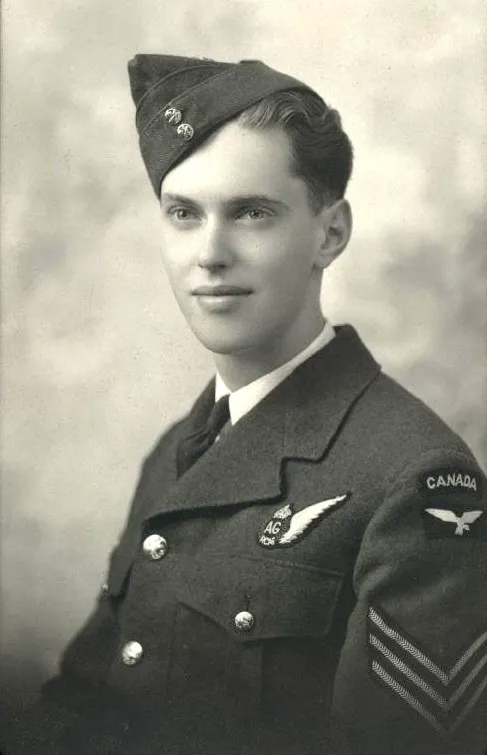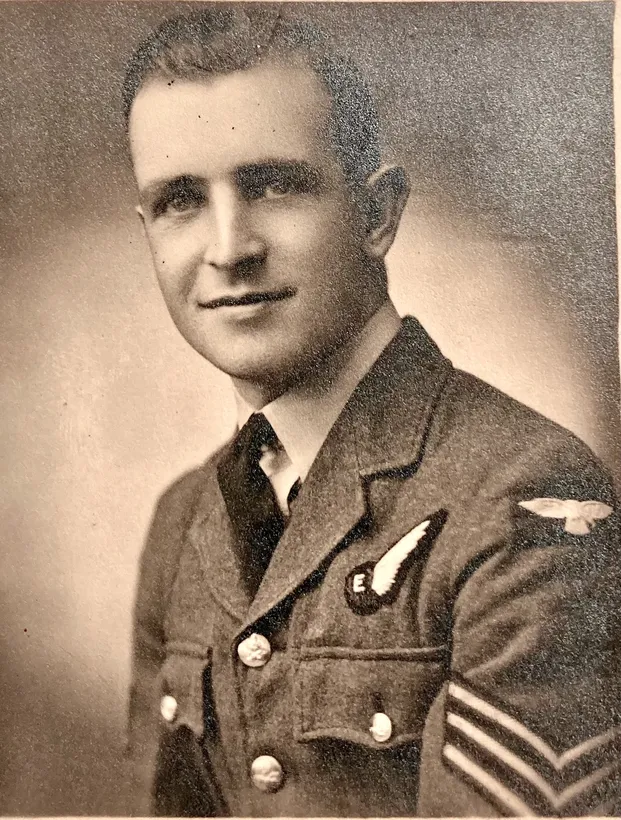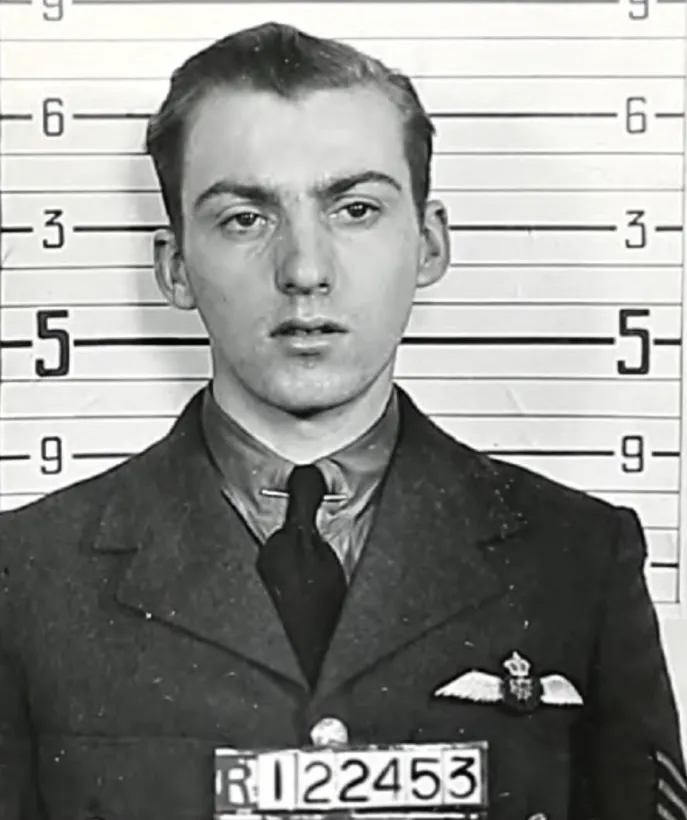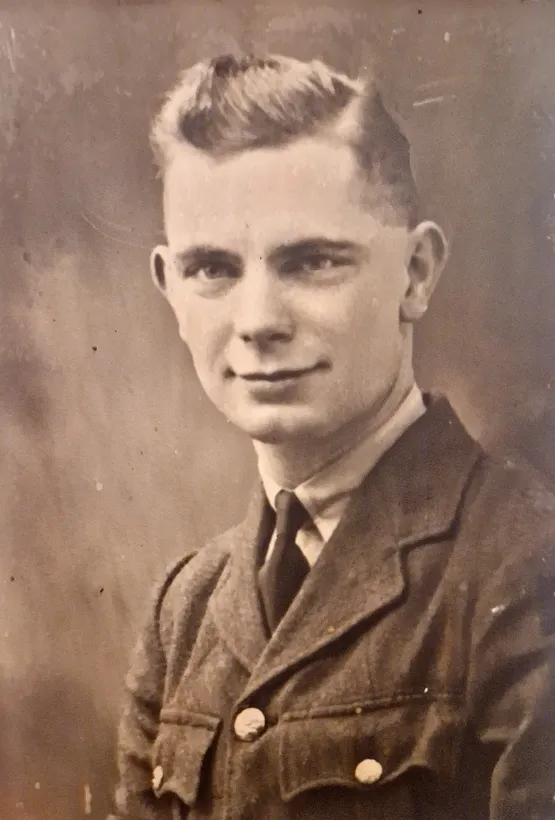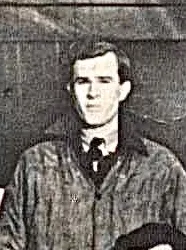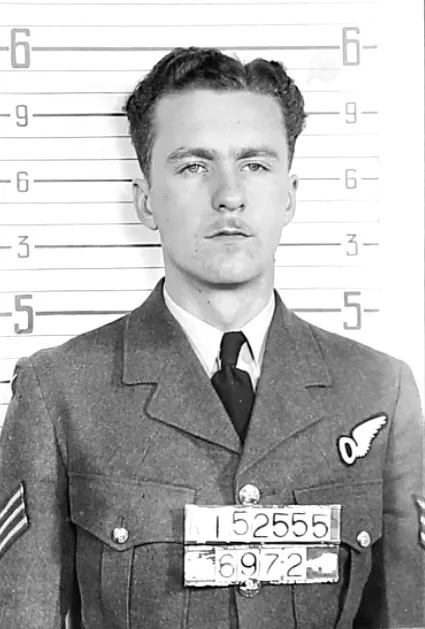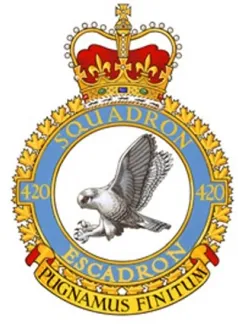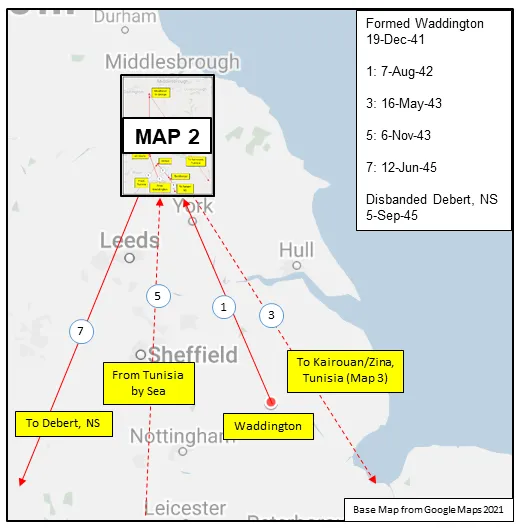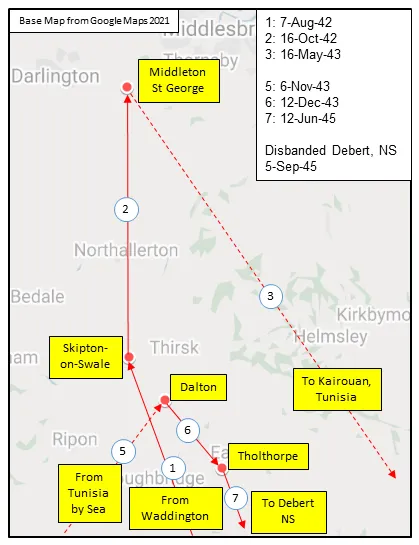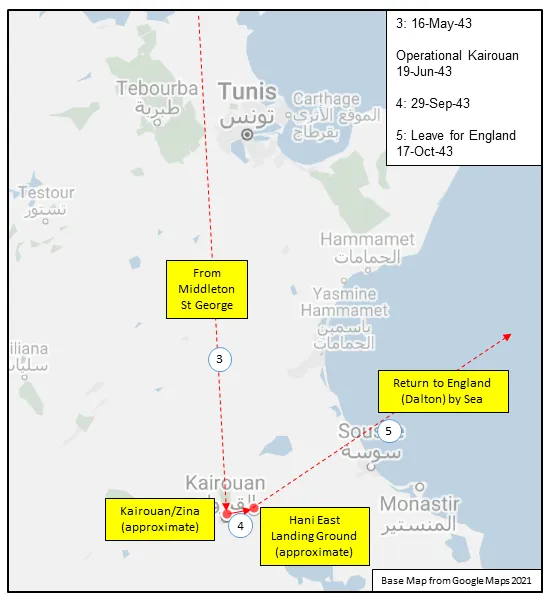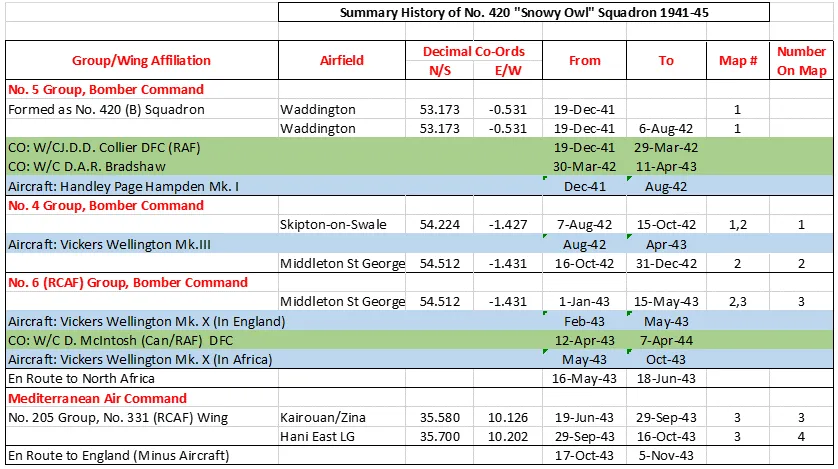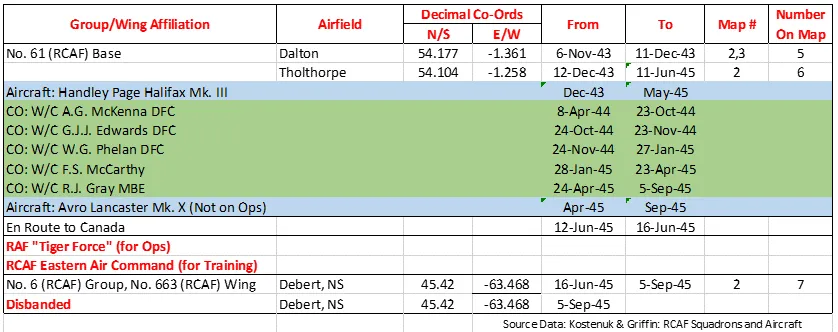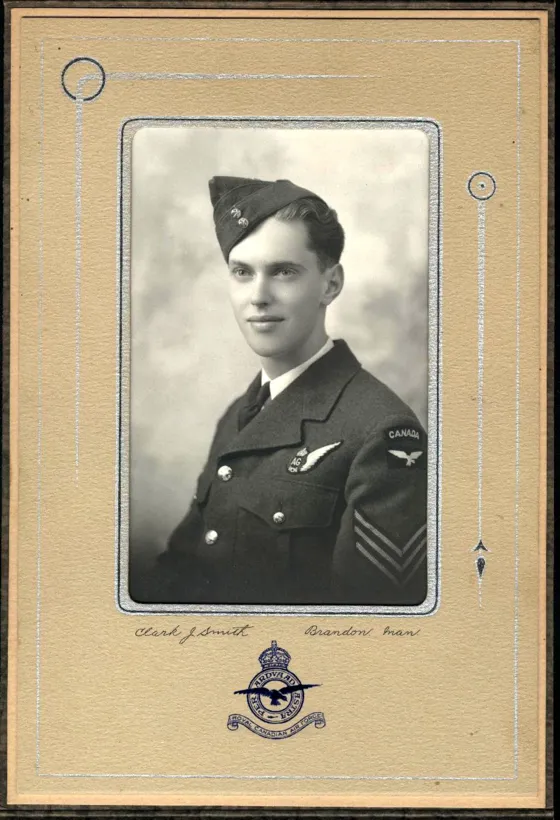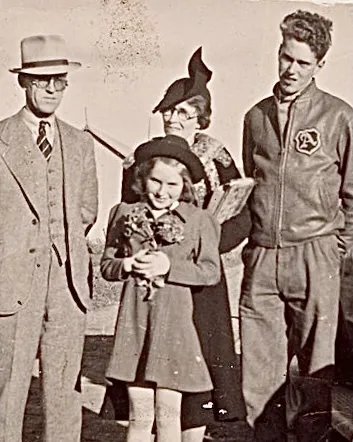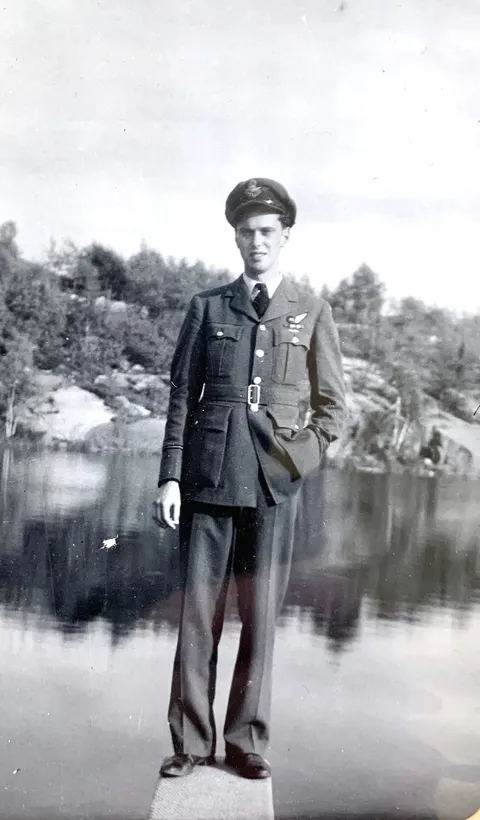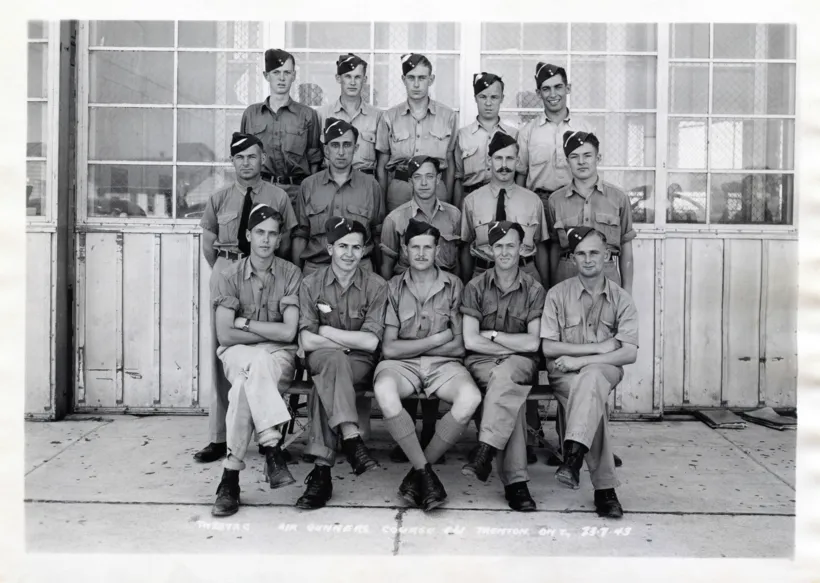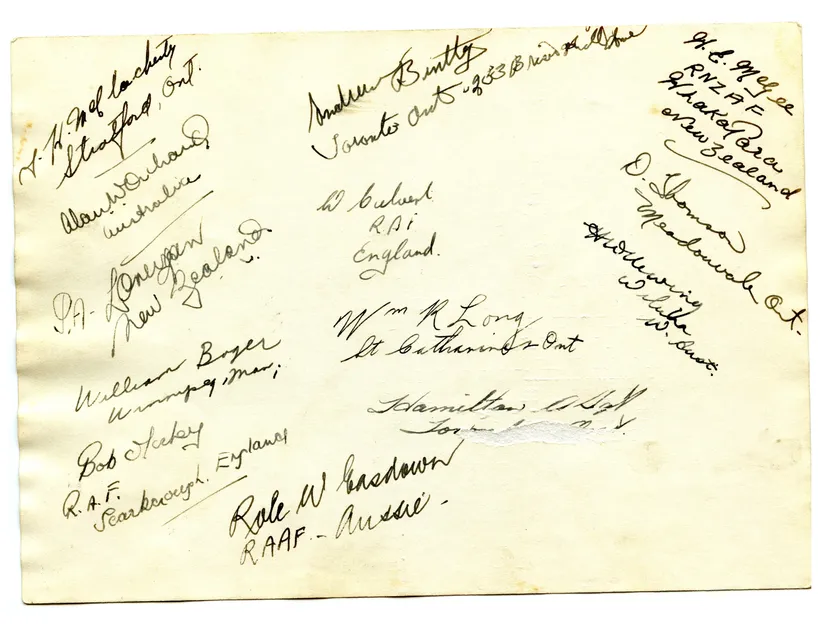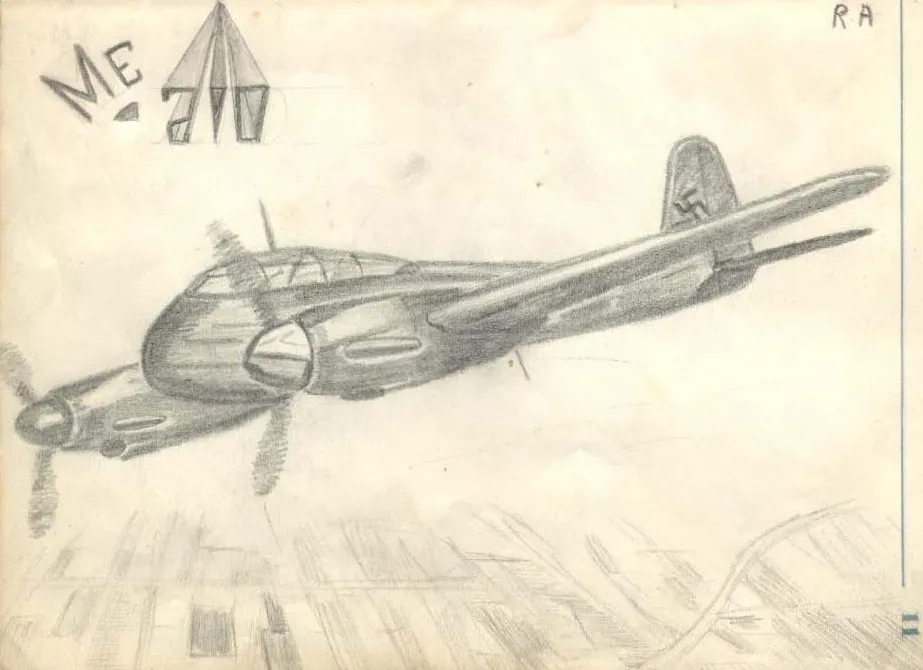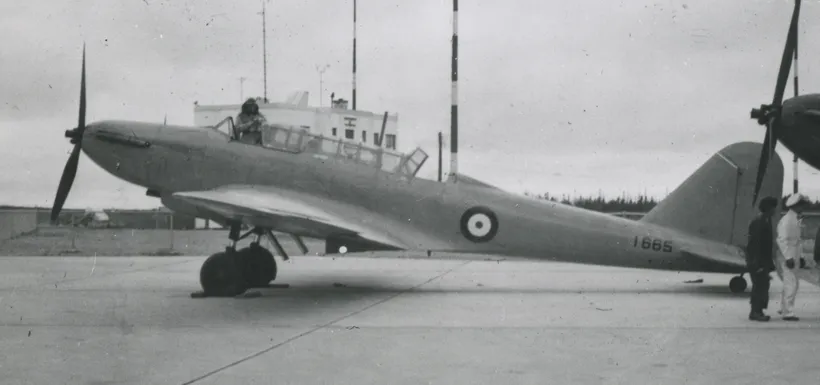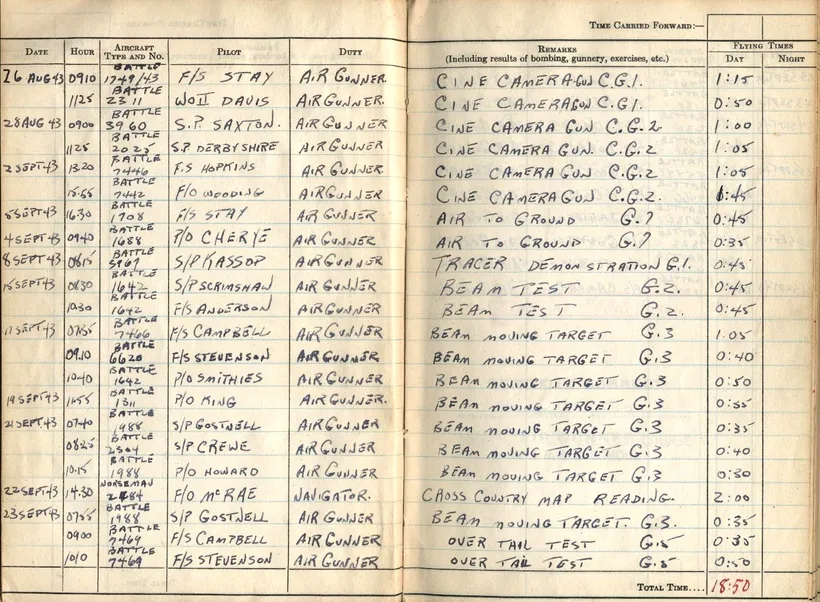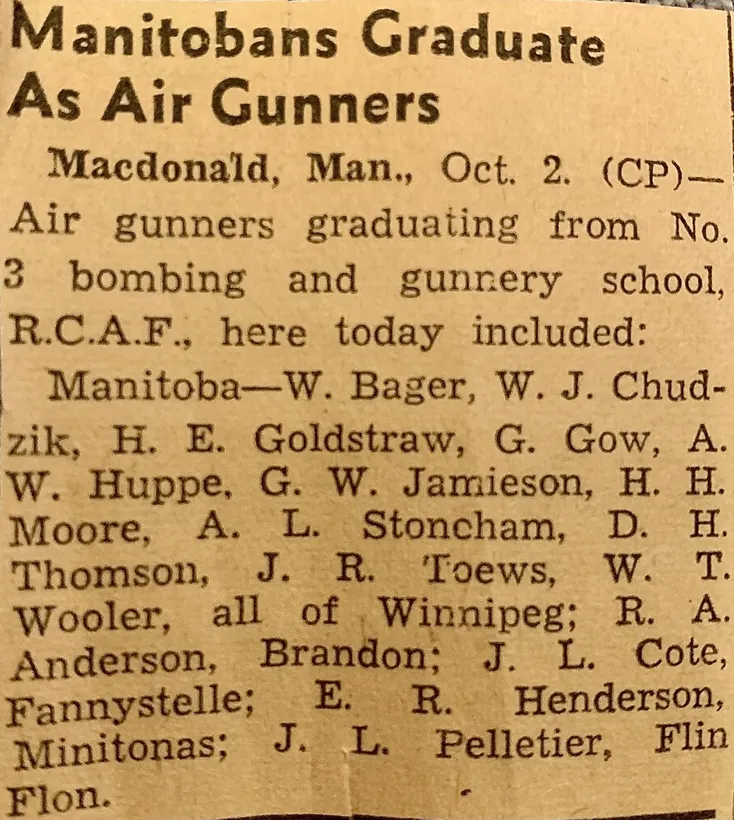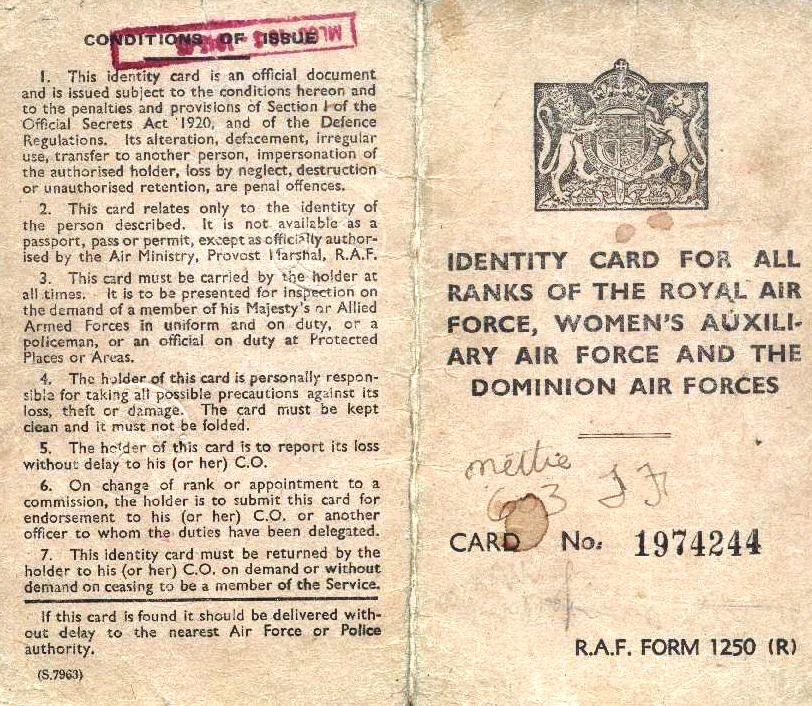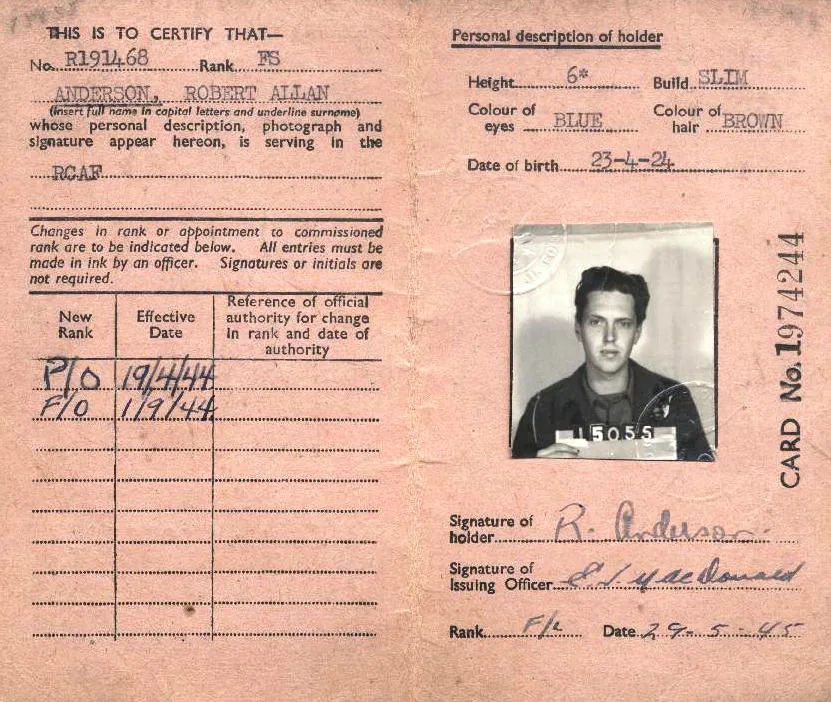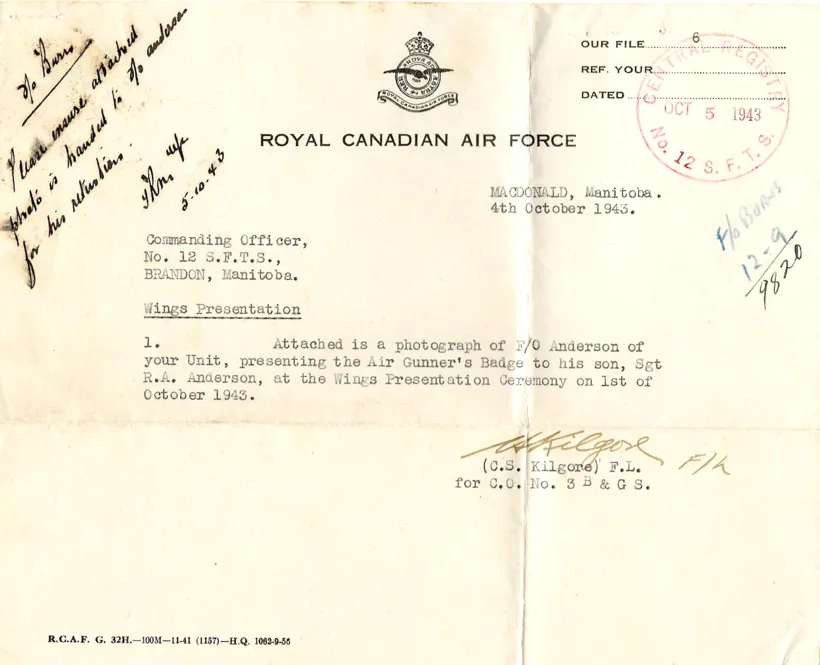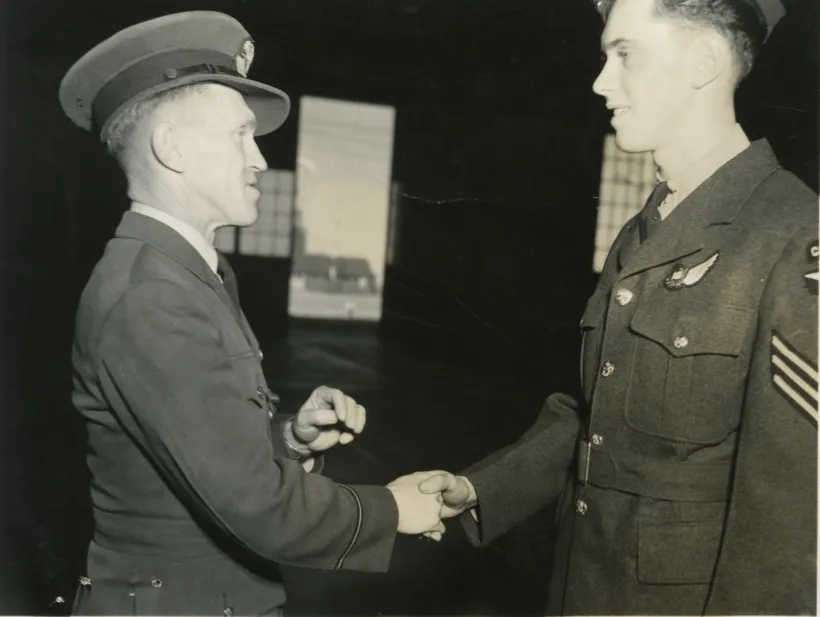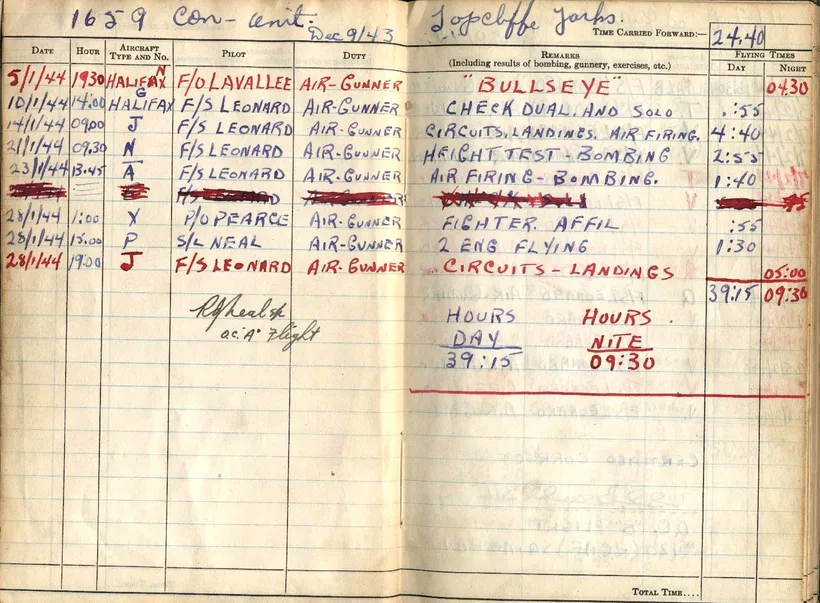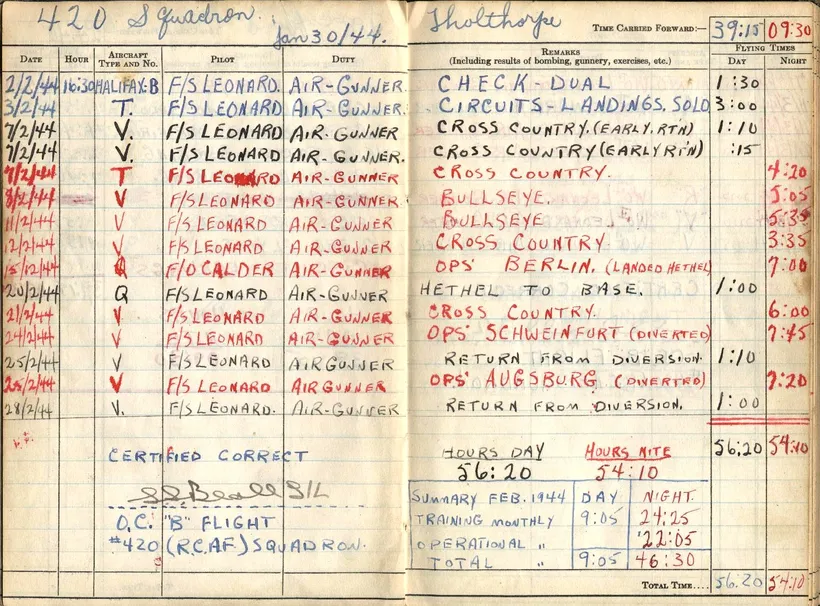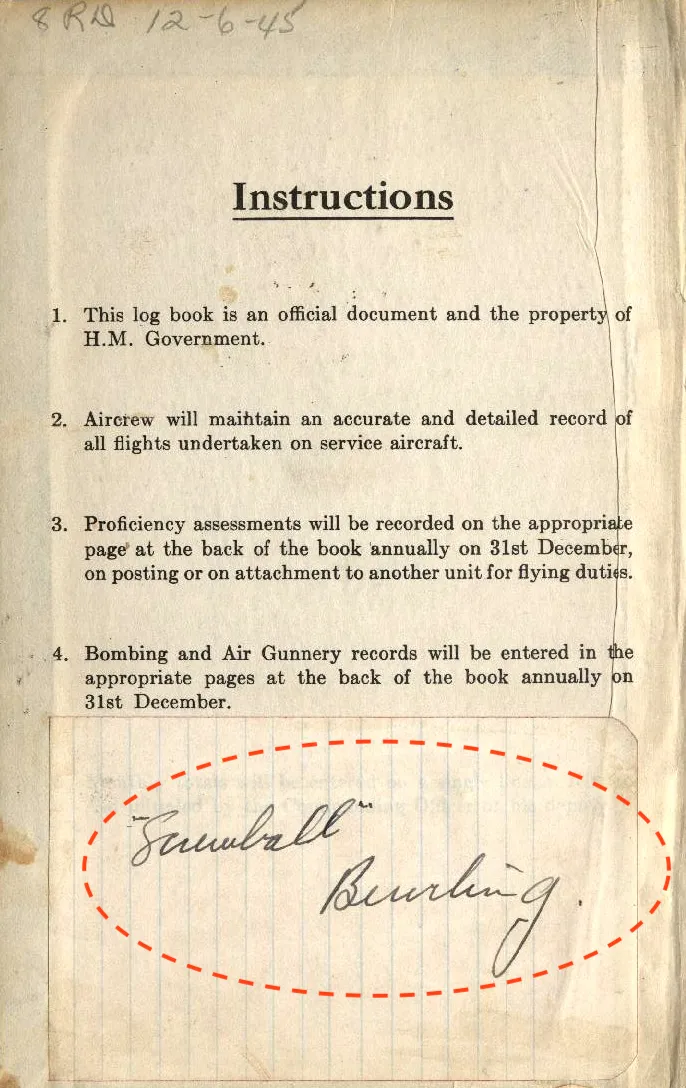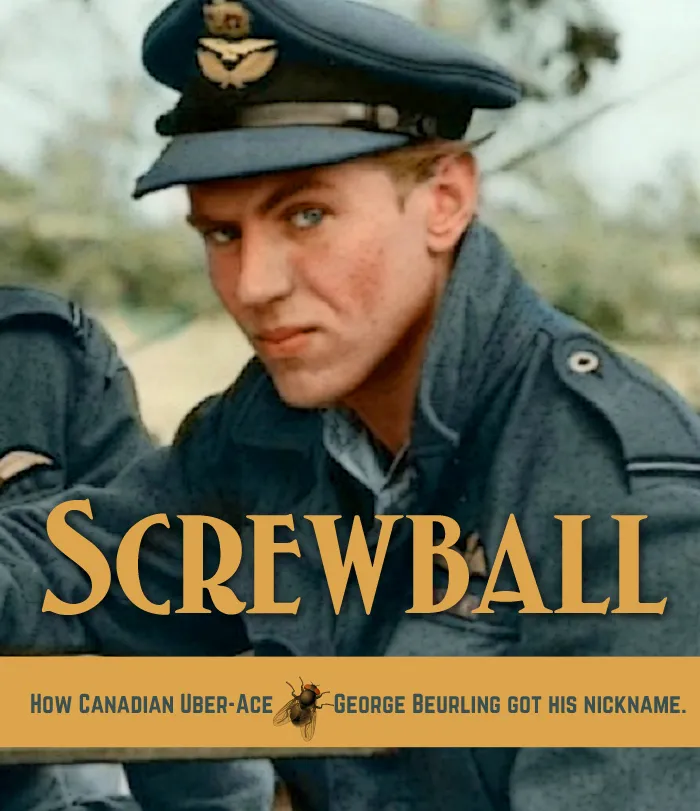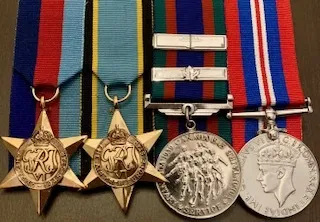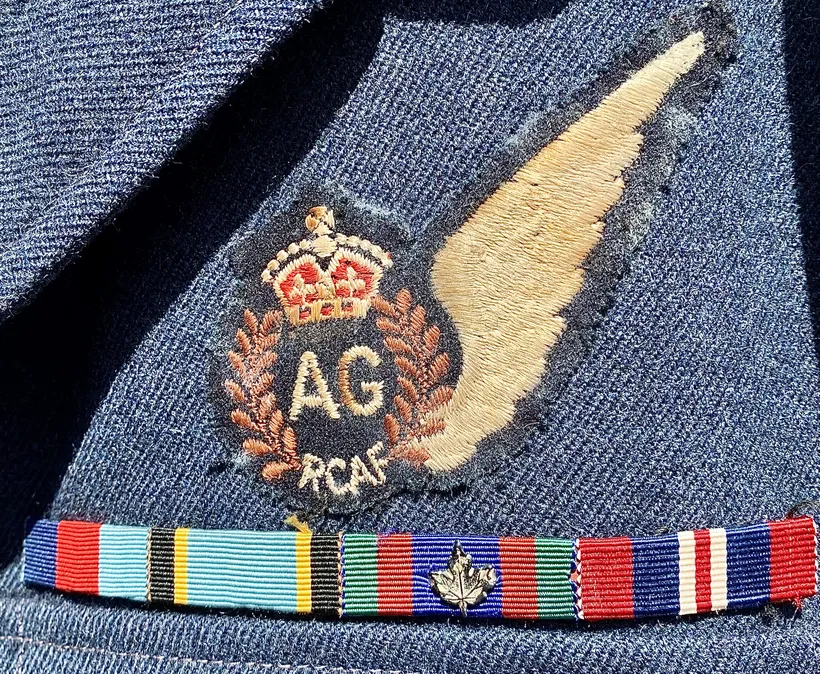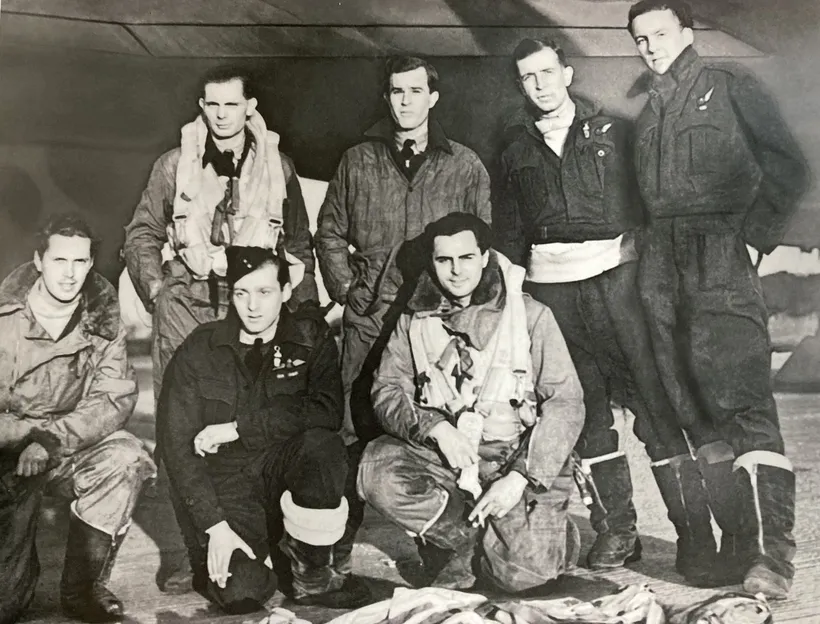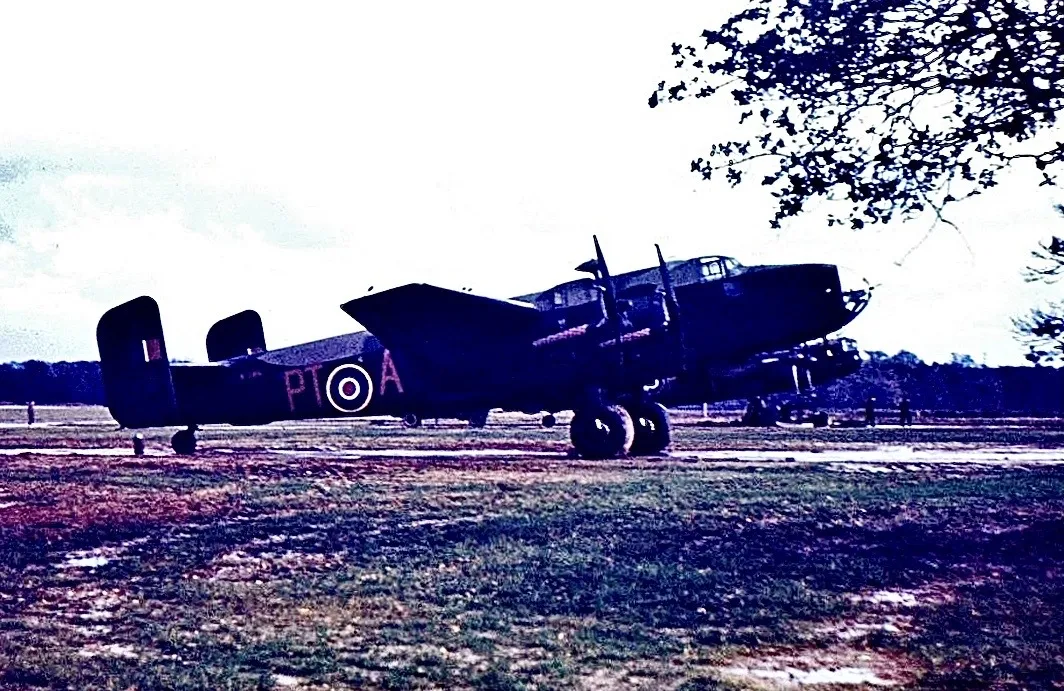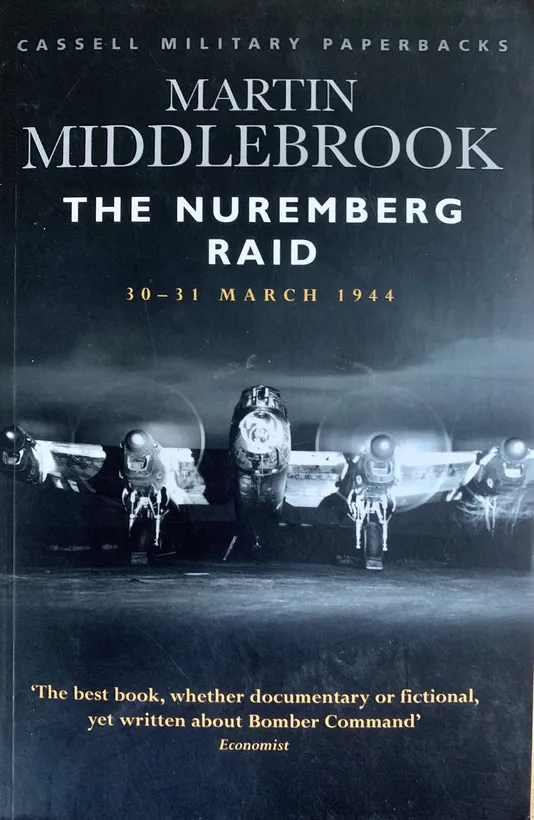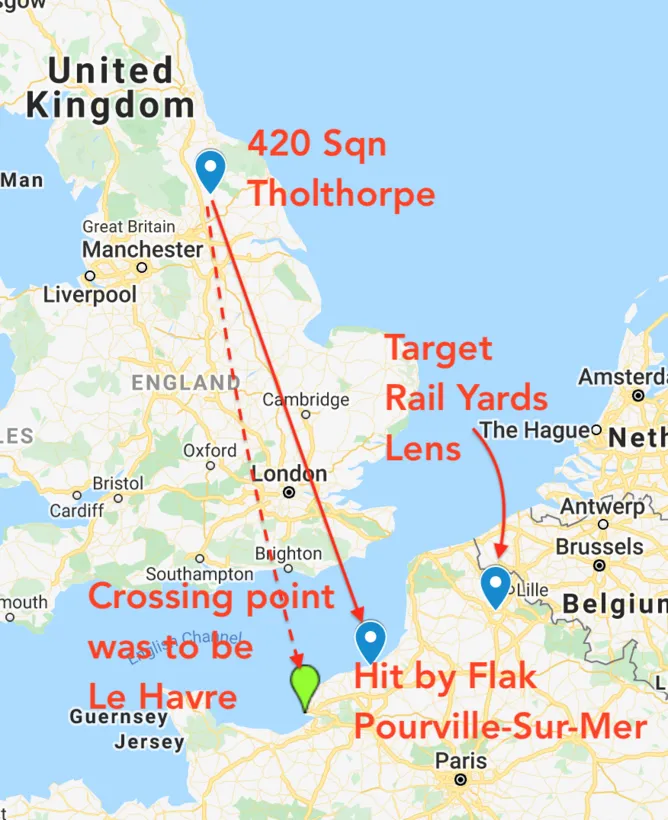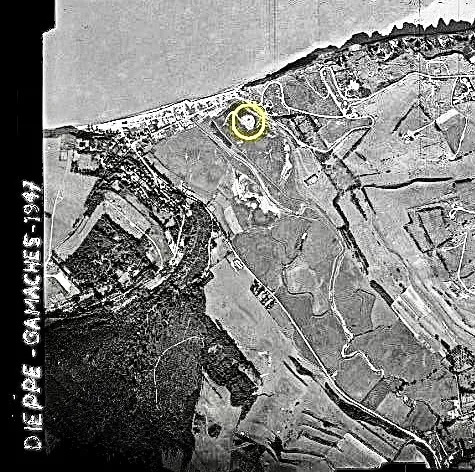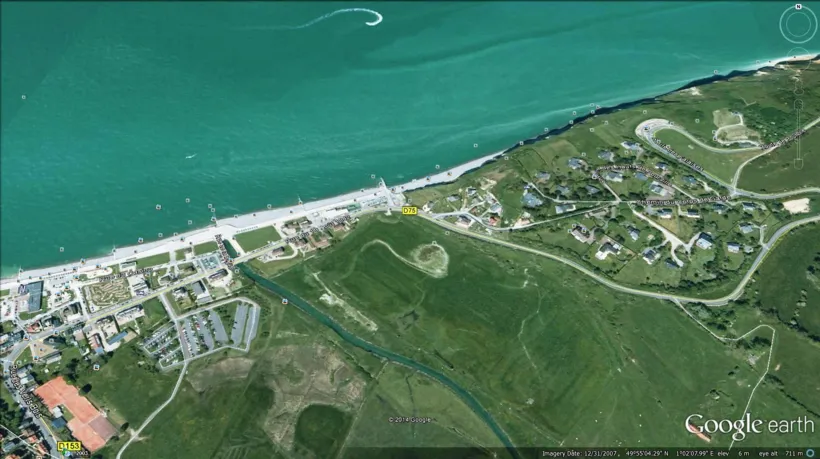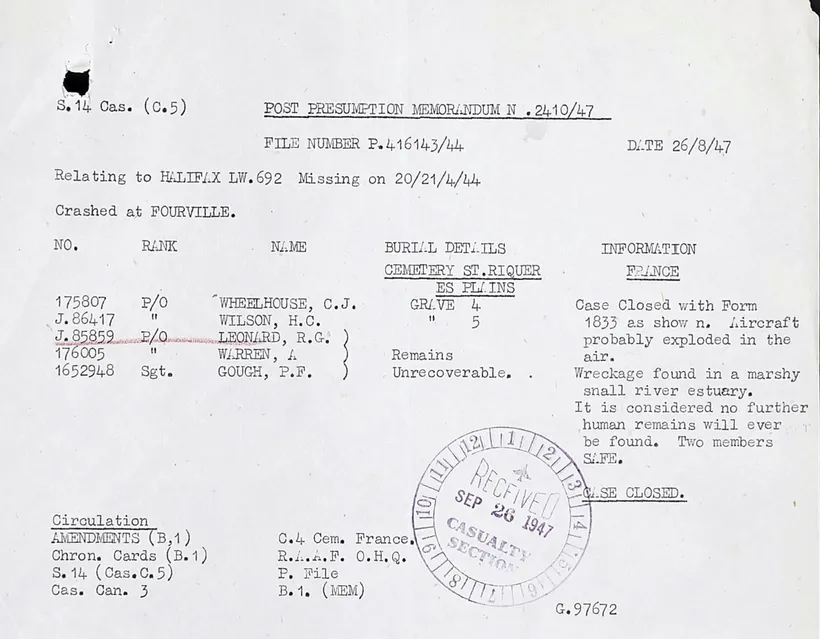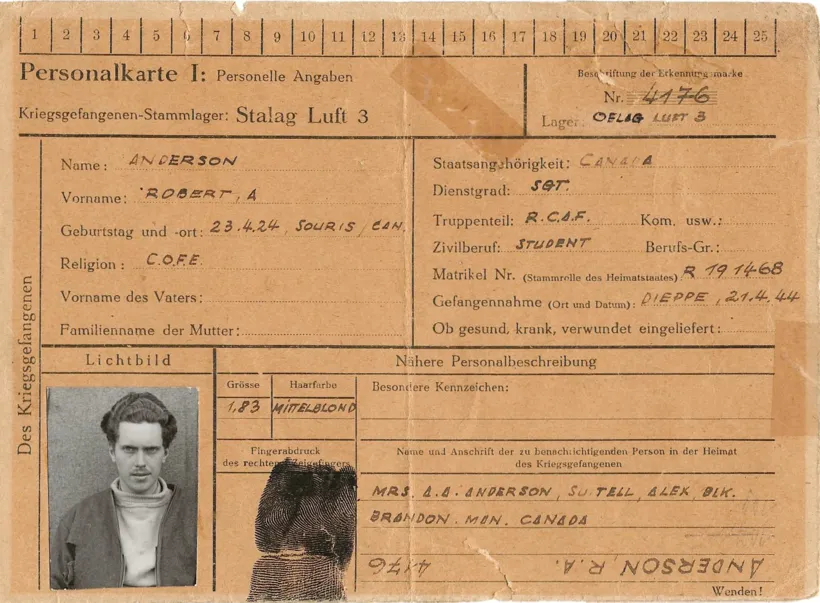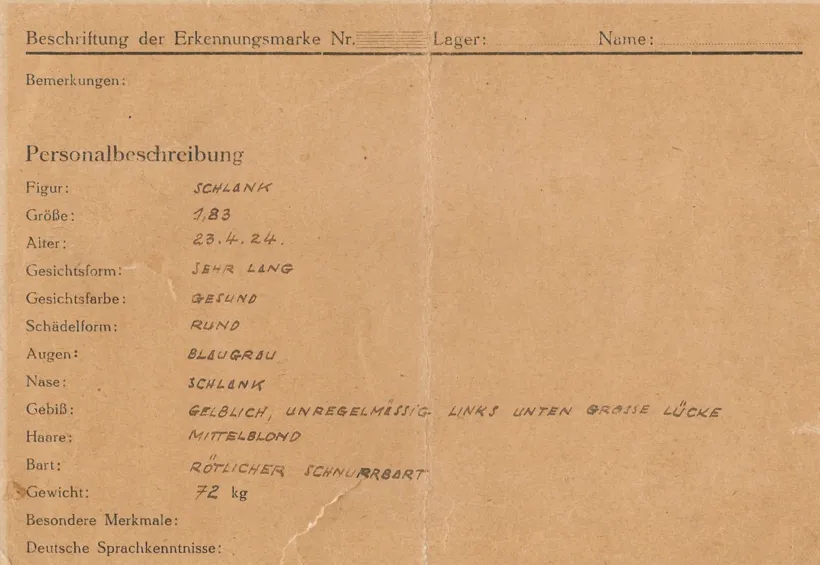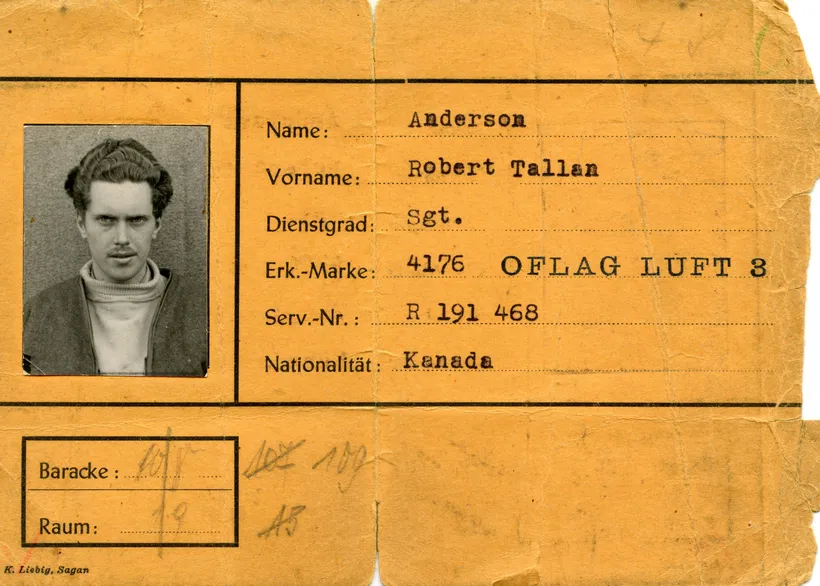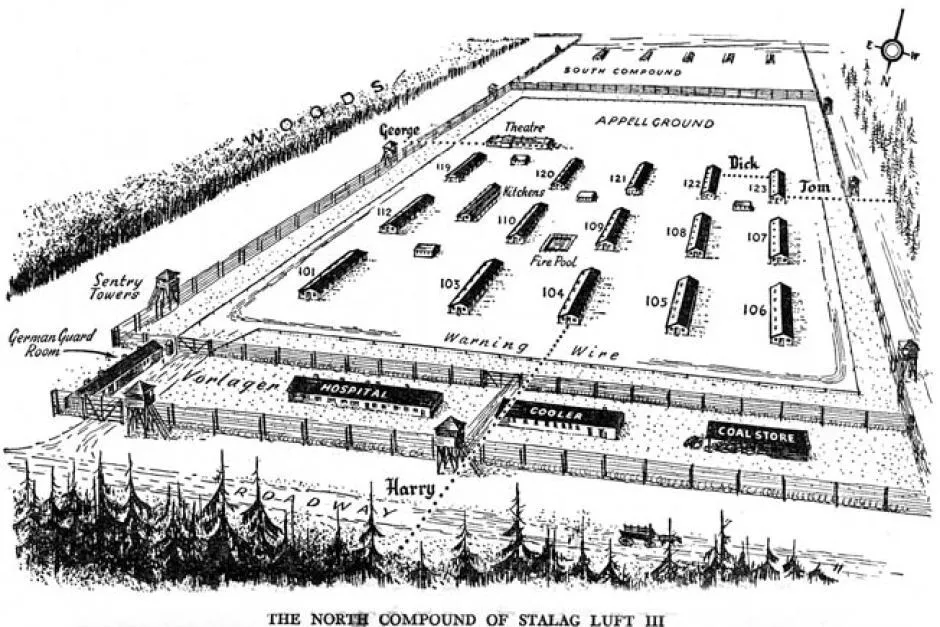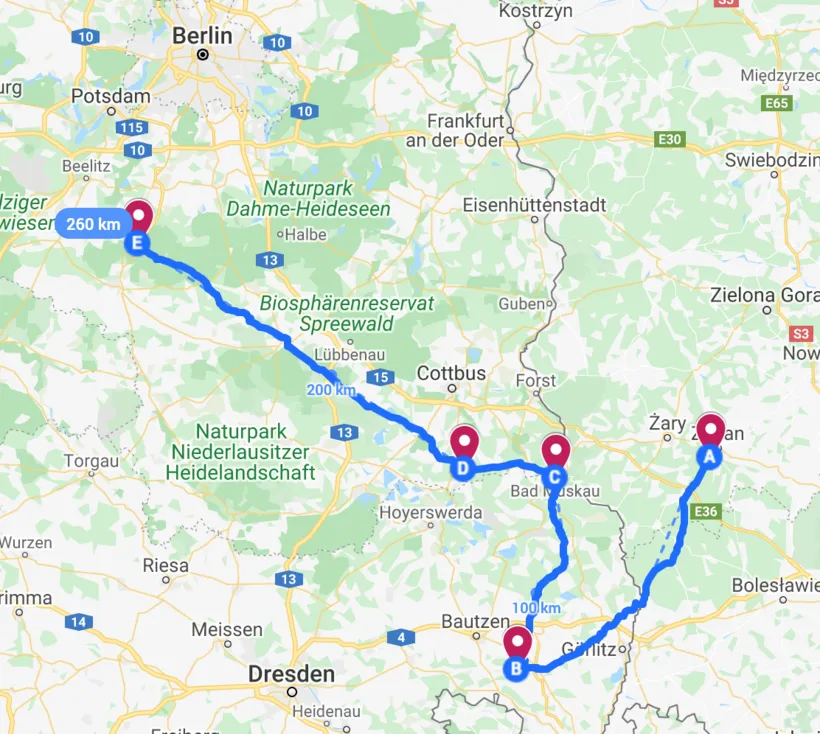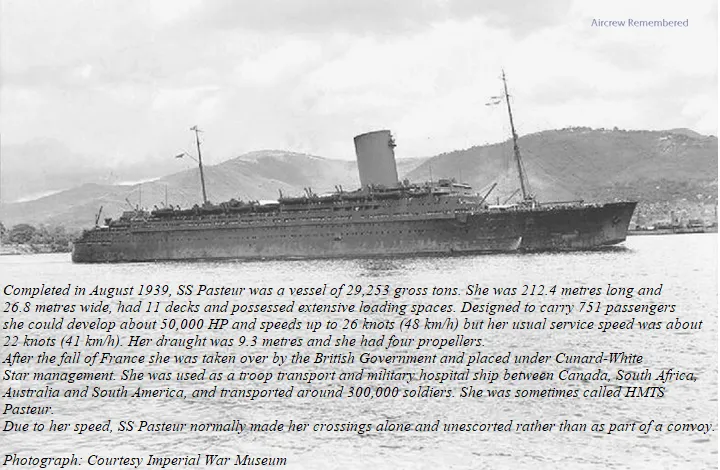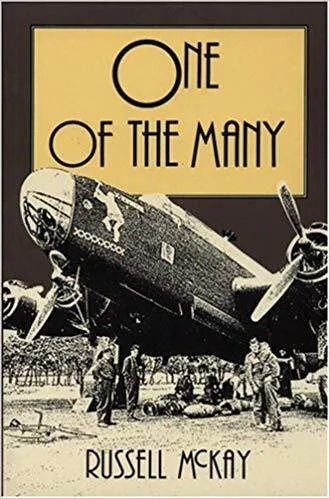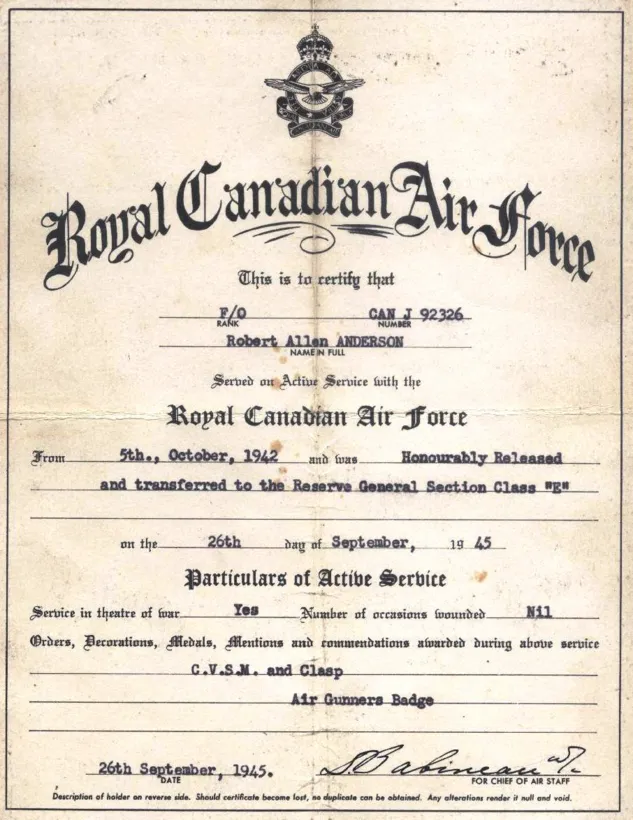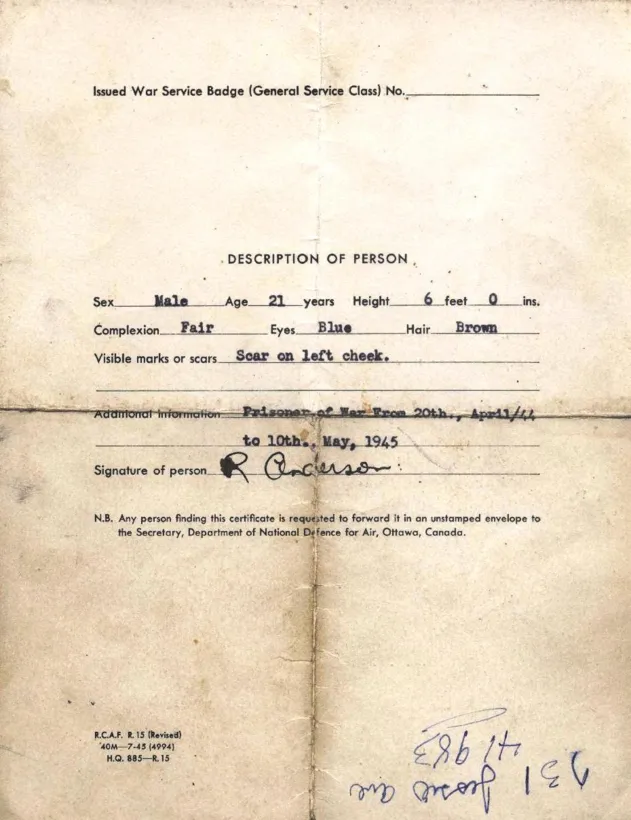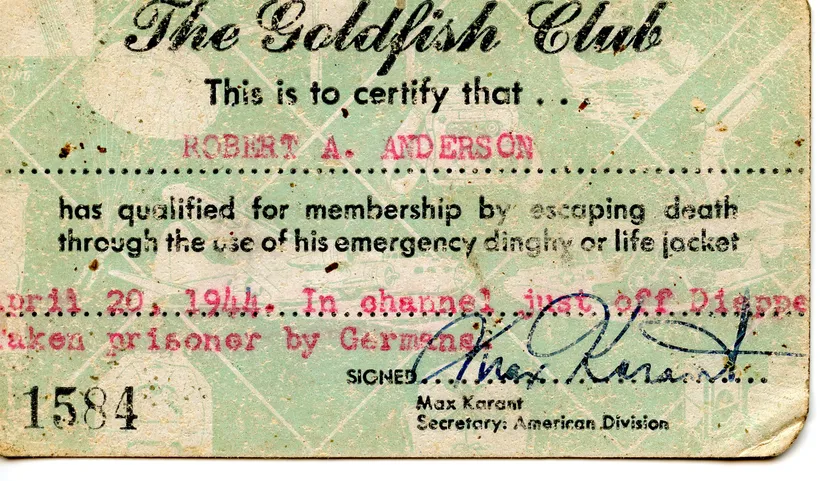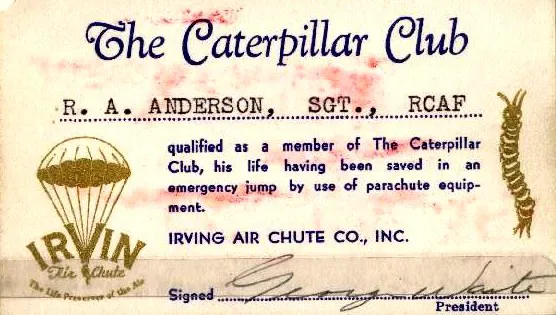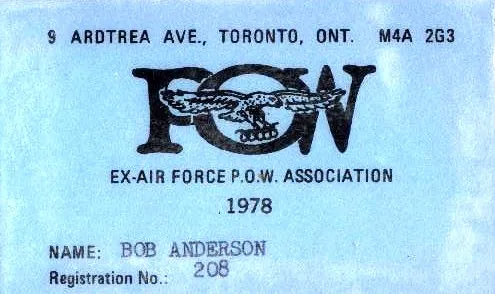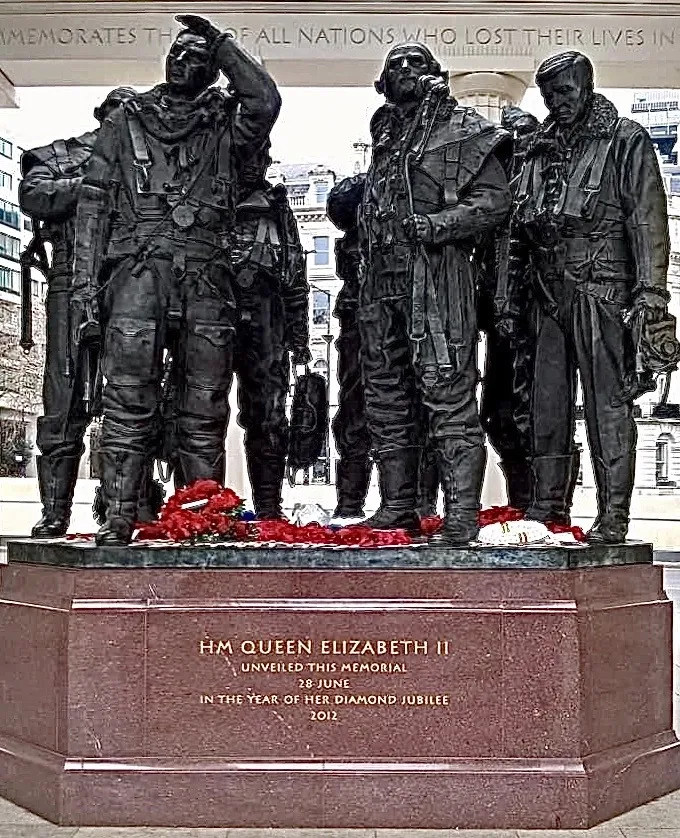My Dad's War
This is the detailed story, from enlistment to return home, of a south-western Manitoba student who flew combat missions, was imprisoned in a Prisoner of War camp, forced marched in the winter of 1945, then returned home to a normal family life in Canada.
Author and Dedication
This history of Pilot Officer Robert Allan Anderson has been assembled by his son Bill Anderson and was submitted to the Canadian Warplane Heritage Museum in November 2020. Robert Allan Anderson was a Sergeant at the time of the crash. Bill Anderson's research used original source materials from the RCAF, his father's journals plus direct explanations from his father. Bill also credits veteran pilot of 420 Squadron and author, Russell McKay, in assisting him, and for the title My Dad's War.
With respect to the title "My Dad's War", I had sent the following letter and information to Russell and in the following May 23, 2009 letter to me, he remarked "Dear Mr. Anderson: I thank you for the huge amount of extremely interesting WW II information pertaining to your Father and his war". When I read those words, I immediately understood what the title of my Dad's story must be!
 Letter to Russell McKay from Bill Anderson
Letter to Russell McKay from Bill Anderson
 Letter From Russell McKay to Bill Anderson
Letter From Russell McKay to Bill Anderson
 Russell McKay Receiving Cross de Guerre
Russell McKay Receiving Cross de Guerre
 Russell McKay Obituary
Russell McKay Obituary
Grandpa & Grandma Anderson
sister Marie and Dad (Robert Anderson)
Pre and Post War Life
My Dad, Robert Allan Anderson, was a typical small-town boy from the Canadian prairies. When World War II broke out, he tried enlisting under age but his Mother would not hear of it! He eventually did enlist and the day he left home to report for duty was one day after his parents, Flying Officer and Mrs. A. A. Anderson, quietly observed their twenty-fifth wedding anniversary.
my brother John and I asked him what bombing looked like and after thinking about it for a minute, Dad took us into the kitchen, turned off all the lights and in darkness, turned on the stove's large element. When it glowed red, he sprinkled pepper on it to simulate exploding bombs and said "It looks something like this".
He served with the Royal Canadian Air Force and became a Prisoner of War in Stalag Luft 3, Sagan Germany (now Zagan Poland) after the aircraft in which he was a tail gunner was shot down and later, Stalag III-A (Luckenwalde) after "The Long March". While he did not speak much about his war experiences, as kids, we learned about the 420 "Snowy Owl" Squadron out of Tholthorpe from him, as well as many types of WW2 bombers and fighters including German, Stalag Luft 3 and III-A and the "Great Escape". I remember once my brother John and I asked him what bombing looked like and after thinking about it for a minute, Dad took us into the kitchen, turned off all the lights and in darkness, turned on the stove's large element. When it glowed red, he sprinkled pepper on it to simulate exploding bombs and said "It looks something like this".
After the war, he worked for the Manitoba Telephone System for thirty years and was a member of the Fort Garry United Church, the Ex-Air Force PoW Association and the Fort Garry Branch of the Royal Canadian Legion. He served as President of the Fort Garry Community Club and coached kids in baseball and hockey for many years. He enjoyed curling as well as fishing and hunting waterfowl with my brother John and me and our Grandfathers. He also enjoyed trips to England, Ireland, Scotland, Paris and Hawaii with his wife, our Mother Patricia. Unfortunately he was never able to enjoy retirement. He passed away on March 17, 1979 at 54 years of age.
Training - BCATP (British Commonwealth Air Training Plan)
July 1943: Classroom in Trenton Ontario
becoming a fully qualified air gunner.
Anderson drawing of a German ME210
Robert Anderson enlisted on September 27, 1942 and finally reached operations on January 30, 1944. It took a full 15 months of training to create a qualified air gunner in the RCAF:
- Manning Depot in Brandon
- Initial Training Schools in Regina and Saskatoon
- Gunnery training in Trenton
- hands-on training in Macdonald Manitoba
- operational training in Britain
Finally assignment to operations at 420 "Snowy Owl" Squadron in Tholthorpe, UK.
No 2 Manning Depot - Brandon Manitoba
The Royal Canadian Air Force Manning Depot No. 2 in Brandon was used during the Second World War and was the first such training facility in Western Canada (Manning Depot No. 1 was in Toronto). The building was converted from what was left of the Manitoba Winter Fair Building to suit the military organization's needs.
This is the introduction to the military: disciple, rank structure, bed making, grooming, marching.
Air Gunners Course - Trenton Ontario
When my Dad enlisted in the Royal Canadian Air Force, he wanted to become a pilot. That opportunity disappeared after it was discovered that he had Red-Green Color Blindness. He then chose Air Gunner training under the British Commonwealth Air Training Plan.
Aircraft recognition was a core skill expected of any air gunner. Know your opponent! It was so important, that it was drilled and drilled into each trainees head. They also had to draw the planes as well as they could. Robert Anderson drew very well. At right is an image of a Messerschmidt ME210 drawn absolutely beautifully by Sergeant Anderson in the summer of 1944 while in Stalag Luft 3. This also gives an excellent idea of what the camp looked like.
Other training skills were basic map reading, gun maintenance (although armouring was left to a different trade), and all the concepts in deflection shooting.
Deflection shooting is a technique used for effectively propelling a projectile at a moving target, also known as leading the target, i.e. shooting ahead of a moving target so that the target and projectile will collide.
This is not always true. For example when shooting directly to port or starboard, the bullet moves not only away, but also travels forward at the same speed as the aircraft, to it may at times be necessary to lag the target. The whole point is, shooting from a moving platform to another moving object is very complex. It takes training and lots of practise.
The Canadian and British Bomber Command flew almost exclusively at night. All training in Canada was day time training. Night training began in Britain with 1659 HCU (Heavy Conversion Unit). This is when the crew was upgraded to 4 engine bombers.
Number 3 Bomb & Gunnery School Macdonald Manitoba
First Events at 3 B&G from Log
No. 3 Bombing and Gunnery School was formed on 10 March 1941 and was located at Macdonald, Manitoba. Under the original Organization Order No. 90, dated 8 January 1941, the School was to have been formed on the same date but at Dafoe, Saskatchewan. The School had begun their Daily Diary on 1 February 1941. No 3 B&GS was part of the British Commonwealth Air Training Plan within No 2 Training Command. No 3 B&GS and was disbanded on 17 February 1945.
Arrived at Macdonald Manitoba in late August 1943. Now to put the classroom into practice. Macdonald was near Lake Manitoba. All bombing and gunnery practice was to take place over the lake.
The aircraft of choice for gunnery training is the single engine Fairey Battle. The Fairey Battles were a mid 1930's aircraft and were very unsuccessful against German planes. They were shipped to Canada to be used for training in the BCATP. Bombing training used other twin aircraft.
 Bomber Command Museum: Gunner Details
Bomber Command Museum: Gunner Details
 Bomber Command Museum: Air Gunner Tactics
Bomber Command Museum: Air Gunner Tactics
 Bomber Command Museum: Best Air Gunners in the RCAF
Bomber Command Museum: Best Air Gunners in the RCAF
No 3 B&G School was in Macdonald Manitoba. Typically Bomb Aimers trained by dropping smoke bombs on floating targets in Lake Manitoba, while gunner trained by shooting at towed drones. The exercises were taking place in Fairey Battle aircraft.
 Fairey Battle
Fairey Battle
- Cine Gun Camera CG1 - The Turrets were fitted with cine cameras, which recorded the accuracy of the Students shooting and showed whether the Gunner was firing high or low in relation to the Target.
- Cine Gun Camera CG2 - more complex shooting and aiming.
- Air to Ground - Hitting fixed ground based targets.
- Beam Test - Shooting to "beam" is shooting to the left or right or the aircraft; out to the side. You might think that you can shoot straight at the target, but you cannot. In fact because the aircraft is moving forward at 300+ km/hr so is the bullet when it leaves the gun. Therefore the air gunner must actual lag the target to compensate. this is common for a mid-upper gunner.
- Beam Moving Target - Yet another complication in an already complicated shooting scenario.
- Cross Country map Reading - knowing where you are in the air.
- Over Tail Test - Shooting at a target approaching from the rear. This is the most common for a rear or tail gunner.
Completion of Training in Canada
RCAF Identity Card (front)
RCAF Identity Card (inside)
|
|
October 1943: Flying Officer Anderson presenting
Air Gunner Wing to his son Robert Anderson
On October 3, 1917, my Grandfather married my Grandmother, Nina Marian McMorran, a fellow teacher and in February 1918, he took leave of his job as Principal of Erickson school to pursue undetermined involvement in the First World War. In January 1919, he returned as Principal of Erickson School and later served at Ninga School and Alexander School before joining the Royal Canadian Air Force during the Second World War. He was stationed in the Air Training Command No. 2 at Service Flying School No. 12 and the Wireless School and worked in the Department of Veterans' Affairs as a Supervisor with the Canadian Vocational Training Schools. In 1948 after returning to Selkirk, Manitoba, he resumed his grade-school career in the Selkirk School District as Principal of Victoria School (1948-1956) and Central School (1956-1958) after which he returned to classroom teaching until retirement. He was President of the Royal Canadian Legion (Selkirk Branch No.151) and it is my understanding that he enabled teachers in the Selkirk School District to be eligible for membership in the Legion. The Manitoba Historical Society recognizes some of his life achievements, along with a collection of other noteworthy Manitobans, under the title "Memorable Manitobans."
|
1659 HCU Topcliffe Yorks United Kingdom
January 1944, deployed to 1659 Heavy Conversion Unit at Topcliffe. HCU trained crews on the actual heavy four engine bombers. There was very little HCU training in Canada.
During this period, the practiced the main requirements of the crew.
 RAF Topcliffe
RAF Topcliffe
- Bullseye - cross country navigation at night and locating a target
- Fighter Affiliation - chased by a fighter; learned evasive action (corkscrew flying) and sighting for the air gunners
- 2 Engine Flying - learning to fly with two engines down
- Miscellaneous - Various forms of flying and landings night and day
- Leonard was likely always the crew pilot, but on some flights he was an observing pilot, with a senior instructors taking over.
|
|
Day Gunnery
|
Night Gunnery
|
|
3 B&G
|
24:40 hours
|
0:0 hours
|
|
1659 HCU
|
14:35 hours
|
9:30 hours
|
|
Total Hours
|
39:15 hours
|
9:30 hours
|
January 30, 1944: deploy to 420 "Snowy Owl Squadron" Tholthorpe.
George "Buzz" "Screwball" Beurling
In a December 6, 1943 letter home, Dad told his Father that he was introduced to George Buzz Beurling, DFC DFO etc. and had quite a chat with him. "Got him to sign his name in my log. I'll show you that after I come home". George Beurling, Distinguished Service Order, Distinguished Flying Cross, Distinguished Flying Medal & Bar was the most successful Canadian fighter pilot in the Second World War, credited with shooting down 27 Axis aircraft in 14 days over Malta for an official total of 31 before war's end (Wikipedia).
 Vintage Wings "Screwball"
Vintage Wings "Screwball"
In an article published for Vintage Wings of Canada, author Dave O'Malley writes:
Recently I was reading a yellowed page torn from the Toronto Globe and Mail of September 6, 1949. There was a short interview by columnist and aviation enthusiast Bruce West with another Malta icon, Wing Commander Percy Belgrave LaddieLucas, CBE, DSO and Bar, and DFC Beurling's 249 Squadron commanding officer during his time on Malta.
"As you may know, one of his familiar nicknames was "Screwball". 'There have been all kinds of stories told about how he picked up the nickname, but I was there when he got it and I know. "In Malta," said Lucas, "the flies were simply scandalous. There were millions of them. When you put some food on a plate, they would swarm all over it. Shortly after Beurling arrived, we were sitting there eating our usual thin slices of corned beef. Beurling lifted his plate from the table and placed it on the floor.
"He'd wait there with his foot poised until there were sixty or more flies on his corned beef. Then he'd plant his foot down hard. He seldom got less than about 40 of them. Then he'd sit there looking at them and say "The screwballs!"'
"He used to do that every other day, and it didn't take long before he'd picked up the nickname of "Screwball" Beurling.
Decorations
Air Gunner Wing and Ribbons
Along with his Service Cap, Service and Battle Dress uniforms, Service Medals and Badges including the 1939-1945 Star, the Air Crew Europe Star, the Canadian Volunteer Service Medal with Bomber Command Bar (posthumously received) and Clasp to the CVSM, War Medal 1939-1945, General Service Badge, RCAF Reserve Badge, I am fortunate to possess his original Flying and Wartime Logs; 27 letters home while overseas on operations from November 25 1943 to April 20 1944, the day he was shot down; letters from home, including a letter from his Father dated April 20 1944 that was returned; 12 Official letters and telegraphs to his parents from the day after he was declared Missing In Action, the day he was listed as a Prisoner Of War and to the day he was liberated; 15 letters home from April 30 1944 to January 21 1945 and 27 "Postkartes" from April 30 1944 to January 9 1945, all from Stalag Luft 3, as well as numerous press clippings.
I also have a Wehrmacht gas mask canister and fur flapped tornister back pack which he used to carry his belongings during the "Long March" out of Stalag Luft 3, and a hand made ring bearing an Iron Cross which I expect he traded cigarettes and chocolate for in the prison camp. He once told me that he also had a complete German Officer's uniform which he left behind during the "Long March" as only necessities were carried.
1939-1945 Star Awarded for six months service on active operations for Army and Navy and two months for active aircrew.
Aircrew Europe Star Issued between 03 September 1939 and 05 June 1944. It was not awarded after D-Day and could not be awarded until the-1939`1945 Star was qualified for by 2 months service in an air operational unit. The total requirement to earn both stars is four months.
Canadian Volunteer Service Medal Granted to any person of any rank in the Naval, Military or Air Forces of Canada who voluntarily served on Active Service and honourably completed 18 months total voluntary service from 3 September 1939 to 1 March 1947. In a March 3/44 letter home to his Dad, Dad stated "I see I'm eligible to wear the Canadian Volunteer Medal + Leaf, or what we call the EBGO (everybody's got one)".
Clasp to CSVM A silver bar with a maple leaf at its centre was awarded for 60 days service outside Canada  Awarded to all full-time personnel of the Armed Forces and Merchant Marines for serving for 28 days between 03 September 1939 and 02 September 1945.
War Medal 1939-1945 Awarded for members of the Naval, Military or Air Forces of Canada who have declared their willingness, or who have engaged, to serve in any of the said forces on active service beyond Canada and Overseas, during the present war, and who have been honourably ceased to serve on active service after not less than three months of continuous paid service or by reason of physical disability.
RCAF Reserve Badge and Bomber Command Bar An honour awarded to Canadian Veterans who served with Bomber Command acknowledging that their service was a vital contribution to the eventual Allied victory of the Second World War. The design represents the heavy bombers used by Bomber Command, most notably the Avro Lancaster, the Handley Page Halifax, and the Short Stirling.
Correspondence Home
Mother would often say that she had to hold and console Dad every November 11th as he always found that date to be an extremely difficult day.
While the letters and Postkartes home from Stalag Luft 3 were inspected and censored, they did describe basic day-to-day life in captivity. The letters home to his Dad during "ops" however, describe both the excitement and dangers encountered by bomber command crews, as well as the close relationships crew members developed, even if short lived.
"the rear gunner directs his pilot through flak, search lights and gives the evasive action from fighters, and gives the skipper a running commentary on fighter attacks"
While originally a mid-upper gunner, in a March 3 1944 letter he tells his Dad "Well you might as well know, I got the turret I wanted that is the rear turret. You see, it is just as safe and the rear gunner directs his pilot through flak, search lights and gives the evasive action from fighters, and gives the skipper a running commentary on fighter attacks. I know now a rear gunner is a lookout, an eye so to speak and I know I will only use the guns when it is necessary or when I'll be a fool not to. One instance for eg. I once saw a JU 88 about 100 yds on the starboard beam, a perfect shot but he had not seen us so I told the skipper to swing away off to port and we lost him in the dark. We might have been able to get him but the firing would have only have given our position away to more fighters. A good tail gunner can direct a kite safely through a lot of trouble if he knows what to do. If you see tracers coming up towards you (and I have) swing off and it misses you. Our former tail gunner is French and when he gets excited he gets all balled up. Well, more soon. Love Bob".
In the series "Weaponology", aircraft maintenance engineer Ian Hickling states that the average tour for a tail gunner was 4 ops. Ted Church, author of Tail-End Charlie, states "Estimates for the life expectancy for a WW2 Rear Gunner vary but were never very high, about just 5 sorties".
In a March 6 1944 letter he says "A thing I would really like to do is parachute jump, boy I wouldn't hesitate a second. In fact I'd love to". Forty-five days later he would jump to save his life. He once told me that after that, he had no desire whatsoever to ever jump again!
Instructions to his Dad: "Don't worry Mom".
A common thread in all of his correspondence home, which undoubtedly parallels that of other soldiers, sailors, airmen and POW's, is his strong concern about his Mother's worry about him. This is illustrated particularly in the stories he would tell his Dad as compared to his Mother. For example, in an April 20/44 letter to Grandpa, he says " I hope you won't show my letter of some time ago to Maw, the one I didn't want you to. And don't show her this one either, she doesn't need to know till after the war anyway. In a very recent letter of mine I told her the number of trips I had etc. I'll put some things in her letters so she won't think we've got any secrets from her. Here's a little incident that happened to Johnnie Walker. You've heard me speak of Johnnie before. His crew sleeps in our hut too. We came back the other night and no Johnnie. Here's what happened to him over the target. Another kite above them dropped a 1,000 pounder, it hit Johnnie's right wing, knocked out his 2 engines there, tore a hole in the wing an awful size and greatly weakened the wing. He dropped his bombs ok naturally with only 2 engines and both on the same wing, he'd lose an awful lot of height and speed, so they limped home at a speed of 50 M.P.H. slower then the rest and at a very low altitude. They landed at the first drome in England they saw. It's a very skillful job to land on 2 engines and especially on the same wing. The yawing is terrible due to the drag but Johnnie is an ace at flying and set her down in one piece. The kite is being scrapped, that's how bad it is. Some fun eh. I sure hope he gets the D.F.C. because he earned it. That same night Ray's quick thinking got us out of a spot. I'll tell you about it when I get home. Well don't show this to Maw and for gosh sakes don't give her the impression you are holding anything back. I know you like to tell. All is well. More soon. Love Bob".
In another letter to his Mother, this time from Stalag Luft 3, he states: "When I do come home, there is just one thing I ask and that is you don't meet me at the station. I want to walk home and find you there as I imagine you now. Promise me that. I think of you constantly and if I were to be here 10 years, my affection would not grow less but ever stronger for you".
LW692 Crew - April 20, 1944
Back row left to right:
Sergeant Alfred Warren (RAF) Navigator | Sergeant Clifford Wheelhouse (RAF) Wireless Air Gunner
Sergeant Patrick Gough (RAF) Flight Engineer | Sergeant Clarke Wilson (RCAF) Bomb Aimer
Front row left to right:
Sergeant Robert Anderson (RCAF) Tail Gunner | Pilot Officer Raymond Leonard (RCAF) - pilot
Sergeant Paul Bourcier (RCAF) Mid-upper Gunner
as identified by Bill Anderson
|
RCAF post war reporting:
- Warren - unknown
- Wheelhouse - drowned
- Gough - unknown
- Wilson - chute failed to open
- Anderson - PoW
- Leonard - unknown
- Bourcier - PoW
|
|
After capture, the Nazi's interrogate Bourcier and Anderson. A quick timeline is presented by researcher David Champion:
"Plane goes down, Anderson and Bourcier are picked up. From there they take a train ride to the Dulag Luft (Luftwaffe Interrogation) centre at Oberursel, north of Frankfurt. Most fliers spent between 2-3 weeks there. Treatment ranged from pretty decent to threats to a strange scenario where the Luftwaffe stripped you of all your clothes and locked you in a room with the heat turned up high. They had an interrogator there from Kitchener, Ontario who spoke better English than some of the Canadians there. When the Fatherland called he returned to Germany." I (Bill Anderson) have never discussed the interrogation with my father Robert Anderson. However, a 1945 newspaper article that I was reading, titled 1,600 Airmen Return, Most From Captivity, it says "Shot down by flak over Dieppe in April of last year, Flying Officer Bourcier and his friend Flying Officer Bob Anderson of Winnipeg were subjected to a severe quizzing by the Nazis at a Frankfurt interrogation centre. When they refused to talk, they were sent to Stalag Luft III in Upper Silesia".
Both Anderson and Bourcier were sent to the North Compound of Stalag Luft 3, Sagan Germany (now Zagan Poland), arriving shortly after 50 airmen were recaptured and murdered by the SS under the direct order of Adolph Hitler for their part in what became known as "The Great Escape".
|
 Anderson Flying Log Book
Anderson Flying Log Book
- Information source: Flying Officer Robert Allan Anderson , through his son Bill Anderson of Winnipeg Manitoba Canada.
- Canadian Air Force Flying Log Book for Aircrew other than Pilot All aircrew keep a log of their air time.
- Robert Anderson flew out of Tholthorpe in Halifax Bombers coded PT-A, PT-B, PT-O, PT-Q, PT-R, PT-T, PT-V and PT-Y, but mostly in PT-V. He flew out of Topcliffe in bombers coded (FD- or RV-) A G J N P X.
- Although this crew were together most of the time, some of these flights did not include each crew member (Anderson's Flight Log was used).
 Selected 420 Squadron ORBs specific to Anderson Bomber Command Museum Nanton AB
Selected 420 Squadron ORBs specific to Anderson Bomber Command Museum Nanton AB
✓ indicates entire crew pictured above on mission.
 420 Squadron day-to-day by Russell MacKay
420 Squadron day-to-day by Russell MacKay
Russell McKay of 420 Squadron wrote about operations in 420 Squadron. This document list each day from Russell McKay's book against the Fliying Log of Robert Anderson. This allows the reader to easily understand the flight log.
Bombing Missions Flown
 Inside a Halifax Bomber
Inside a Halifax Bomber
In January 1944, Anderson was posted to the 420 "Snowy Owl" Squadron in Tholthorpe England, originally as a mid-upper gunner and later as a tail gunner in a Halifax Mark III bomber (Royal Canadian Air Force Flying Log Book for Aircrew other than Pilot).
February 15/16 1944, Halifax LW426 PT-Q bombed Berlin. Piloted by Flying Officer DH Calder, crew members were Flight sergeant. OA Ritchie, Sergeant R.E. Qunnings, Sergeant PE Bethel, Sergeant Patrick Gough, Sergeant Robert A. Anderson and Sergeant W.H. Heidman. The aircraft took off at 1729 and flew 7 hours return, landing at 2355. This was the 420 Squadrons first operational sortie out of Tholthorpe in Halifax III bombers since returning from service in North Africa flying Wellingtons. Details of the Sortie stated "11 aircraft attacked target between 2118 and 2131 hours, height 19,000 to 22,000 feet. Bombs dropped: 264 x 30 lbs., 7920 x 4 lbs. and 990 x 4 lb "X". Attack appeared to be successful but owing to all aircraft early in attack and 10/10th cloud not much could be seen. Heavy flak was slight and in barrage form searchlights not effective. Some aircraft report fire glow could be seen against cloud. All aircraft landed away from base". According to Anderson's Flying Log, PT-Q landed at Hethel and returned to Tholthorpe, 195 miles away, on February 20, piloted by Flight Sergeant Leonard. 1:00 Flying Time day. All Dates, Aircraft, Crew, Flight Times and Details of Sortie from Operations Record Book, Bomber Command Museum of Canada Archives
Flight Sergeant Alfred Warren was known as "Pops" because he was so old. He was 25.
✓ February 24/25, Halifax LW366 PT-V bombed Schweinfurt. Piloted by Warrant Officer Class 2 Raymond Leonard (Anderson's Flying Log indicates Flight Sergeant Leonard), crew members were Warrant Officer Class 2 Clarke Wilson, Flight Sergeant Alfred Warren, Sergeant Clifford Wheelhouse, Sergeant Paul Bourcier, Sergeant Robert Anderson and Sergeant Patrick Gough. The aircraft took off at 1820 hours and returned 7.45 hours later, landing at 0327 hours. Details of the Sortie state "Attacked between 2310 and 2320 hours, height 23,000 to 25,000 feet. Bombs incendiaries. Attack appeared to be successful but rather scattered - opposition moderate heavy flak barrage to 23,000 feet. Searchlights not effective. Weather no cloud, slight ground haze. Ground detail visible". Anderson's Flying Log shows "Diverted - 25/2/44 Return From Diversion 1:10 (Flying Time Day).
✓ February 25/26, Halifax LW366 PT-V bombed Augsburg. Piloted by Warrant Officer Class 2 Raymond Leonard (An's Flying Log indicates Flight Sergeant Leonard), crew members were Warrant Officer Class 2 Clarke Wilson Flight Sergeant Alfred Warren, Sergeant Clifford Wheelhouse, Sergeant Paul Bourcier, Sergeant Robert Anderson and Sergeant Patrick Gough. The aircraft took off at 2130 hours and flew 7.29 hours, landing at 04:47 hours. Details of the Sortie stated "Attacked between 0113 and 0123 hours, height 22,000 to 23,500 feet. Bombs incendiaries. Crews report fires all over the town with large columns of black smoke rising up to 16,000 feet. The P.F.F. were on time and the markers were well concentrated. Weather over target was clear with slight ground haze, probably smoke. All aircraft attempted photographs. A few fighters were in the target area". Anderson's Flying Log shows "Diverted - 28/2/44 Return From Diversion 1:00 (Flying Time Day).
March 7/8, Halifax LW382 PT-Q bombed Lemans. Piloted by Warrant Officer Class 2 Raymond Leonard, crew members were Warrant Officer Class 2 Clarke Wilson Flight Sergeant Alfred Warren, Sergeant Clifford Wheelhouse, Sergeant Paul Bourcier, Sergeant Robert Anderson and Sergeant R.K. Wyatt. The aircraft took off at 1848 hours and flew 5.15 hours return, landing at 0002 hours. Details of the Sortie stated "Five aircraft attacked target from 2123 to 2147 hours, from 12,000 feet. Bombs, 6x1000 + 9x500. PFF markers were absent at Wave zero hours, causing large numbers of aircraft to circle over approximate target area waiting for markers. This caused the majority of aircraft to bomb late. Number of bomb bursts and flashes soon reflected on clouds. Large explosion white turning red in colour, seen. Weather 10/10th cloud overf target, tops 6/8000 ft".
Rare Photo of Halifax Bomber LW386
courtesy of Owen Merrick (Pilot Raymond Leonard's Great Nephew) and and Michael Baillargeon
✓ March 11 Training Flight, Halifax LW386 PT-A piloted by Warrant Officer Class 2 Raymond Leonard and with crew members Warrant Officer Class 2 Clarke Wilson, Flight Sergeant Alfred Warren, Sergeant Clifford Wheelhouse, Sergeant Paul Bourcier, Sergeant Robert Anderson and Sergeant Patrick Gough, participated in a short fighter affiliation exercise.
✓ March 24/25, Halifax LW692 PT-V, piloted by Warrant Officer Class 2 Raymond Leonard and with crew members Warrant Officer Class 2 Clarke Wilson, Flight Sergeant Alfred Warren, Sergeant Clifford Wheelhouse, Sergeant Paul Bourcier, Sergeant Robert Anderson and Sergeant Patrick Gough, set off for "Target Berlin". The aircraft took off at 1851 hours but was forced to return early due to undercarriage problems. It flew 2.35 hours, landing at 21:25 hours.
✓ March 26/27, Halifax LW590 PT-R, piloted by Warrant Officer Class 2 Raymond Leonard, bombed Essen. Crew members were Warrant Officer Class 2 Clarke Wilson Flight Sergeant Alfred Warren, Sergeant Clifford Wheelhouse, Sergeant Paul Bourcier, Sergeant Robert Anderson and Sergeant Patrick Gough. The aircraft took off at 2021 hours and flew 5.00 hours, landing at 0123 hours. Details of the Sortie stated "13 aircraft attacked target from 24,000 feet between 2202 and 2216 hours. Black smoke rising to 22,000 feet H/F lights to moderate in barrage form up to 24,000 feet. Weather 10/10th clouds in layers 8,000 feet".
March 30/31, Halifax LW692 PT-V, piloted by Warrant Officer Class 2 Raymond Leonard, bombed Nuremberg. Crew members were Warrant Officer Class 2 Clarke Wilson, Flight Sergeant Alfred Warren, Sergeant Clifford Wheelhouse, Sergeant JOB Masse, Sergeant Robert Anderson and Sergeant Patrick Gough. The aircraft took off at 2208 hours, flew 7:39 hours return and landed at 05:39 hours. Details of the Sortie stated "12 aircraft attacked, two returned early, between 01:15 and 0125 hours from 20,000 feet, Bombs 50 x 30, 100 x 4. Attack appeared successful with PFF, markers and flares rather widely spread. Several crews reported explosions. Weather: was 5/10th 10/10th thin at 20,000 feet with thin layer of clouds about 10,000 feet. Landed at Ford". Russell McKay told me (Bill Anderson) that he missed the Nuremberg Raid because he was getting his appendix out in Scotland.
The Nuremberg Raid 30-31 March 1944
ISBN 0-304-35342-6
While the Bomber Command Operations Record Book, 420 (R.C.A.F.) Squadron, Form 541 states that the raid was successful, of the 782 bombers that took part in the raid, 96 bombers and 545 crewmen were lost, more than the total that died during the entire battle of Britain!
Martin Middlebrook, in his book "The Nuremberg Raid", states "Sir Arthur Harris, Commander-in-Chief of Bomber Command "¦ remained convinced that all-out attacks against the major cities would be the decisive factor in bringing the war to an end. He had anticipated that by 1 April 1944 his bombers would have caused in Germany "a state of devastation in which surrender is inevitable'. On the night of March 30, on what should have been a routine "maximum effort' raid to Nuremberg, Bomber Command suffered its heaviest loss of the war. Out of 779 bombers on the raid 96 were missing, while due to weather conditions over the target area Nuremberg was only lightly damaged."
In a letter home to his father, dated April 2/44, Anderson said, "I don't know where you got the idea that Luftwaffe was nearly dead. I got a kick when you said that ops over enemy territory would soon be just a ride. It sounds good to hear of terrific Nazi fighter losses but never underestimate your enemy. I think the Luftwaffe is a long way from dead, but I hope I am wrong. The boys sure took a beating the other nite by losing 97 kites, it was from fighters too. There was no flak at all. I know, I was there. We had a good trip and laid our eggs on the target ok. It was a lovely night. Moon light, that was the trouble, visibility was too good. It was so good that the Bomb Aimer got a pin point on the Rhine river and that's something. It gives me a thrill every time we cross the enemy coast you can see it so plain".
In his book, Middlebrook also quotes Anderson saying, "The only thing the Nuremberg Raid achieved was probably to raise morale in the Third Reich".
In another letter home to his father dated April 17/44, Anderson noted that while his aircraft was in the hangar getting its landing gear checked over, he stated that he "was looking it over and found a fair sized chunk of shrapnel sticking in her". He took out a screwdriver, dug it out and said that he would keep it as a souvenir and show it to you after the war. He then added, "We must have picked it up at Nuremberg" and also noted that he would be 20 years old in six days.
April 9/10, Halifax NA509 PT-B, piloted by Warrant Officer Class 2 Raymond Leonard, bombed Villeneuve St. George. Crew members were Warrant Officer Class 2 Clarke Wilson, Flight Sergeant Alfred Warren, Sergeant Clifford Wheelhouse, Sergeant N.C. Lewis, Sergeant Robert Anderson and Sergeant Patrick Gough. The aircraft took off at 2053 hours and flew 5.25 hours, landing at 0214 hours. Details of the Sortie stated "Bombs 6 x 1000, 8 x 500 M.O., Attacked target at 0004 hrs. from 15,000 feet. Markers, TK. Red and green both, also ground detail clearly visible. Bombing appeared to be well concentrated around T.I. A large explosion lasting for several seconds seen. George U/S. Monixa U/S. Good trip - target clearly visible".
April 10/11, Halifax LW692 PT-V, piloted by Warrant Officer Class 2 Raymond Leonard, bombed Ghent. Crew members were Warrant Officer Class 2 Clarke Wilson, Flight Sergeant Alfred Warren, Sergeant Clifford Wheelhouse, Sergeant JOB Masse, Sergeant Robert Anderson and Sergeant Patrick Gough. The aircraft took off at 2045 hours and flew 3.50 hours, landing at 0036 hours. Details of the Sortie stated "Bombs 9 x 1000, 6 x 500, M.G. Attacked target at 2251 hrs. from 13,000 feet. Some of the bombing seemed to be going to the south of the markers, but the raid seemed fairly good. P.F.F. were bang on time and the raid should be successful".
✓ April 18/19, Halifax LW692 PT-V, piloted by Warrant Officer Class 2 Raymond Leonard, bombed Noisy Le Sec. Crew members were Warrant Officer Class 2 Clarke Wilson, Flight Sergeant Alfred Warren, Sergeant Clifford Wheelhouse, Sergeant Paul Bourcier, Sergeant Robert Anderson and Sergeant Patrick Gough. The aircraft took off at 2104 hours and flew 5.25 hours, landing at 02:29 hours. Details of the Sortie stated "Bombs 6 x 1000, 9 x 500, M.C. Attacked target at 0000 1/4 hrs. from 15,000 feet PFF well concentrated. Large yellow explosion seen at 0007 hrs. PFF seemed bang on. Appeared to be a good shot. Friendly aircraft seen to blow up in front of us".
April 20, 1944 - Hit By Flak
✓ April 20 1944, Halifax LW692 PT-V, again piloted by Warrant Officer Second Class Raymond Leonard and with crew members Warrant Officer Second Class Clarke Wilson, Flight Sergeant Alfred Warren, Sergeant Clifford Wheelhouse, Sergeant Paul Bourcier, Sergeant Robert Anderson and Sergeant Patrick Gough, took off to attack the rail facilities at Lens France. LW692 PT-V, carrying a bomb load of 9 x 1000 and 6 x 500 pounds of high explosives, was shot down that evening by flak. Details Of Sortie Or Flight notes state "Missing. Nothing has been heard of this aircraft since take-off".
Weather described by other crew as "Thin Cloud 6/10th to 8/10th tops 5,000 ft."
Of the 154 Halifax bombers that took off, LW692 was the only aircraft that failed to return that night. Robert Anderson and Paul Bourcier, the mid-upper gunner, were its only survivors.
Sergeant Robert Anderson described the event as follows:
"We flew down to south England and over the channel. Reached enemy coast 10 minutes early and off track, we passed over very near Dieppe. They threw up a lot of flak and we got 3 hits, the plane shuddered, slowed down and lost height fast. Port engines went on fire, spread to whole wing, engineer admitted it was hopeless, skipper said bale out.
I got to escape hatch after mid upper gunner and jumped after him, plane was diving very fast and had trouble to get out of slipstream. Saw the plane spiral down on fire and crash. I landed in the mouth of a small river (Scie River) near Dieppe, had to use my Mae West, not a scratch."
Sergeant Paul Bourcier's account stated:
"After taking off and setting course for Southern England and then the channel we got off course and reached the enemy coast ten minutes before time over Dieppe, which was about 20 miles off course, as Le Havre was the crossing point.
We were picked up by radar and we were hit 3 times by flak, causing trouble to port engines, the necessary measures were taken, but fire started, and spreading rapidly on the port wing, I was then given order to bale out, which I did and by doing so landed safely. Out of front hatch."
1947 Pourville-sur-Mer
LW692 crash crater
Recent Pourville-sur-Mer
LW692 crash crater
 Returned Escape Evader Report on LW692
Returned Escape Evader Report on LW692
 Dieppe Newspaper article by Laurent Viton
Dieppe Newspaper article by Laurent Viton
"Only Paul and I got out. The plane was diving. We were more than lucky to get out."
Letter from Stalag Luft 3
A witness who spoke with French Researcher Laurent Viton, said that he saw the aircraft explode just over a marshy estuary of the Scie River at Pourville France. The crater that was left is not only visible in the 1947 aerial photograph shown below which was taken by the French Geographical Survey (Institute Geographique National), but remains visible today.
"I haven't heard of him [Pilot Raymond Leonard] since he told us to bail out, but I don't think he had time to bail out, after he fought to keep it steady while we jumped, it was burning so. It was shot to pieces and we owe our hides to him for the way he battled and kept control of it so we could jump."
Letter from Stalag Luft 3
Laurent also stated "It couldn't be seen in 1944 as the area was flooded by the Germans to prevent an allied landing after the disastrous Jubilee (Dieppe) Raid in 1942 and as a forbidden area, locals were not allowed going close to the coast".
On June 28th, 1945, a letter was sent to Raymond Leonard's Father indicating that a Royal Air Force and Dominion Air Force Missing Research and Inquiry Service had been organized for the purpose of research and inquiry in liberated territories into the circumstances of aircrews reported as casualties. (see links below)
August 26 1947: Final Decisions Made - CASE CLOSED
CASE CLOSED
On November 26th 1947, a letter from the Undersecretary of State, Air Ministry, London stated that the Graves Registration Service of the War Office found that the St. Riquier es Plains Cemetery to be unsuitable and on March 2nd, 1948, a letter was sent from the R.C.A.F Casualty Officer in Ottawa to Mr. Wilson confirming that his son had been re-interred in the Grandcourt British Military Cemetery, 19 miles East Southeast of Dieppe and that his son lies at rest in Row E, Grave No 5. (see links below)
PoW Stalag Luft 3, Sagan Germany (now Zagan Poland)
 Anderson PoW Log Book
Anderson PoW Log Book
A Wartime Log for British Prisoners is a log kept by many PoWs.
- Dad stated in a June 4/44 letter home from Stalag Luft 3 "We Canadians had our picture taken the other day, a group from west Canada, Manitoba and three of us from Brandon who are here". Gord King, front row 4th from the left, was a participant in "The Great Escape", who I had the pleasure of meeting through my Dad. According to an article about King in the Edmonton Journal on November 11, 1999, "he was the 146th Allied airman to win a chance at freedom through the escape tunnel 10 metres below the prisoner of war camp in Germany. By a quirk of fate, he never had his chance in the tunnel before it was discovered. And by good fortune, he was not one of those who paid for the escape with their lives. "I was lucky I wasn't anywhere near getting out' ".
- Dad's Log also lists the names of numerous POWs from Australia, Canada, England, New Zealand, Scotland, South Africa, Wales and the United States that he met in Stalag Luft 3, including their rank, address and the type of plane they were in when shot down.
- The Last Mile To Luckenwalde from Wartime Log starting on page 69.
- On page 77, dated March 3, Dad writes "Max Schmelling was in the camp (Stalag III A) for about an hour today. He gave the boys his photo and autograph. Some senior officers were very annoyed". Max Schmelling was the former heavyweight champion. Schmelling article on page 25 is not original.
"I spent my birthday in Paris [1944-04-23]." (20th birthday) letter home Stalag Luft 3 1944-04-30
After capture, the Nazi's interrogate Bourcier and Anderson. A quick timeline is presented by researcher David Champion:
"Plane goes down, Anderson and Bourcier are picked up. From there they take a train ride to the Dulag Luft (Luftwaffe Interrogation) centre at Oberursel, north of Frankfurt. Most fliers spent between 2-3 weeks there. Treatment ranged from pretty decent to threats to a strange scenario where the Luftwaffe stripped you of all your clothes and locked you in a room with the heat turned up high. They had an interrogator there from Kitchener, Ontario who spoke better English than some of the Canadians there. When the Fatherland called he returned to Germany." I (Bill Anderson) have never discussed the interrogation with my father Robert Anderson. However, a 1945 newspaper article that I was reading, titled 1,600 Airmen Return, Most From Captivity, it says "Shot down by flak over Dieppe in April of last year, Flying Officer Bourcier and his friend Flying Officer Bob Anderson of Winnipeg were subjected to a severe quizzing by the Nazis at a Frankfurt interrogation centre. When they refused to talk, they were sent to Stalag Luft 3 in Upper Silesia".
Both Anderson and Bourcier were sent to the North Compound of Stalag Luft 3, Sagan Germany (now Zagan Poland), arriving shortly after 50 airmen were recaptured and murdered by the SS under the direct order of Adolph Hitler for their part in what became known as "The Great Escape".
 RAF interrogation Training Film
RAF interrogation Training Film
 Britain Defence Secret German PoW Interrogation Analysis
Britain Defence Secret German PoW Interrogation Analysis
While the letters and Postkartes home from Stalag Luft 3 were inspected and censored, they did describe basic day-to-day life in captivity. The letters home to his Dad during "ops" however, describe both the excitement and dangers encountered by bomber command crews, as well as the close relationships crew members developed, even if short lived. The latter further helps me understand why my Mother would often say that she had to hold and console him every November 11th as he always found that date to be an extremely difficult day.
 Stalag Luft 3, Sagan Germany (now Zagan Poland)
Stalag Luft 3, Sagan Germany (now Zagan Poland)
North Compound of Stalag Luft 3
by Ley Kenyon author artist and POW in Stalag Luft 3
Marek Lazarz, Director of the Stalag Luft 3 Museum in Zagan Poland, states that Dad's ID card indicates that he was in building 108 room 19, then in building 107 room 15, and then in building 109 room unknown. Marek added "Sergeants usually lived in room #13, the room near the kitchen annex. You are probably wondering now why he changed the huts. There was no special reason of that. POWs had lot of freedom to operate within compound. Compounds were actually administrated by the POWs itself (by the senior officers, to be exact). So, it could be any reason why he changed the hut. Of course everything was supervised by the Germans and every action within compound was reported." Note: The "Great Escape" took place from building 104 out of tunnel Harry.
My Dad made the following statement on the loss of Halifax Bomber LW692 PT-V and crew members while a Prisoner of War:
"On the night of 20th/21st April, 1944 our aircraft was directly hit by flak near DIEPPE. The aircraft caught fire and the order to bale out was given. I was second to leave the aircraft. I was taken to YUETOT with Sergeant Bourcier. I identified the bodies of Flight Sergeant WHEELHOUSE and W/O WILSON and they were buried near Yuetot."
NOTE: In a March 7, 1945 letter to my Grandmother, the RCAF Casualty Officer stated "Since my letter of August 28th, 1944, further advice has been received from Overseas which states that your son, Robert Allan Anderson, who is a Prisoner of War in Germany, has been commissioned with the rank of Pilot Officer with effect from April 19th, 1944. His Officer's number is J92326. Notification of the promotion has been forwarded to the Department of External Affairs, Ottawa, for transmission to your son".
Then on May 1, 1945, the Canadian Minister of National Defence for Air, "By Command of His Excellency The Governor General" appointed Robert Allan Anderson to be an "Officer in Our Royal Canadian Air Force of Our Dominion of Canada from the Nineteenth Day of April 1944" to the "Rank of Pilot Officer".
I have no idea as to when Dad learned about the promotion!
In his first letter home from Stalag Luft 3, dated 30/4/44, Dad writes "Dear Folks. Well how is all in Brandon? All is ok here and I'm not fooling. You must be glad to know I'm here and someday I'll come home alive and unwounded. "¦ Write to Mrs. Alex Bourcier Chateauguay Village Quebec eh, you remember Paul, well we're still together thank God. I guess we'll be pals till we die. The rest of the crew weren't so lucky. I only got a nose bleed when I bailed out. "¦ My biggest burden is worrying about you because I know you are worrying about me. My spirit is high and I can assure you I'll come home as young and wild as when I left." The letter was received July 20, 1944.
Only Paul and I got out. The plane was diving. We were more than lucky to get out.
While he does not say a lot of the crew members who were missing, in his second letter home from Stalag Luft 3 on May 2, 1944, he does state "Only Paul and I got out. The plane was diving. We were more than lucky to get out". In a Postkarte dated June 9/44, he added "Have you met Clarke Wilson's folks yet? If so you can tell them Clarke had a nice burial at a little town about 30 miles south west of Dieppe. I was there. Mebbe you have looked up Ray's folks and I gave you Paul's folks address (we're still together)".
In a Postkarte home dated Oct 20/44, he told his Dad "When the parachute opened, my boots jerked off". When my Dad's sister Marie and her daughter Roxanne visited Paris many years later, Marie remarked that she had to walk down the Champs Élysées and under the Arc de Triomphe to be where her brother walked after capture with only one shoe!
Leonard ... fought to keep it steady while we jumped, it was burning so.
In another letter dated October 27, 1944, he states "I also have a letter from Mrs. Leonard, which I don't quite know how to reply but must. She wants to know about him, I haven't heard of him since he told us to bail out, but I don't think he had time to bail out, after he fought to keep it steady while we jumped, it was burning so. It was shot to pieces and we owe our hides to him for the way he battled and kept control of it so we could jump. Cliff Wheelhouse was buried with Clarke and I know nothing of the rest".
In a December 13, 1944 letter, he says "In our room we have 5 English boys. 2 are Fleet Air Arm and have been down since early 1940, 3 are RAF prisoners from 2 to 3 years, there are 4 Canadians including Paul and myself W.O. Hal Lindlater from Vancouver shot down 3 days after us and W.O. Will Hamilton from Montreal a PoW since 42 plus 3 Americans shot down in July, they're swell guys".
See my Dad's Wartime Logbook for an original photograph of Manitobans in Stalag Luft 3 Source aircrewremembered.com for some background on each.
The Long March And Liberation
Estimated Route of Long March: A Sagan (Zagan) | B Halbau (Ilowa)
C Muskau (Bad Muskau) | D Spremberg | E Luckenwalde
As the Russians advanced towards Germany in 1945, Hitler gave the order to evacuate POW camps and move POWs closer to Berlin.
 The March (1945)
The March (1945)
 Stalag Luft 3 Museum: The Long March
Stalag Luft 3 Museum: The Long March
The Long March was cold and gruelling. There is an account of an American soldier carrying a German guard's gun because the guard was too weak. The only goal was survival. A Wartime Log by Art and Lee Beltrone
On Saturday January 27 1945, Dad and thousands of other POWs were told to gather their meager belongings and a forced exodus began. Dad recorded a day-by-day account of the march in his Wartime Log under "The Last Mile To Luckenwalde".
There were many reports of zig-zag marches, seemingly random direction. They did not always go straight from one location to the other. A Wartime Log by Art and Lee Beltrone
After a nine-day trek, Dad ended up in Stalag IIIA Luckenwalde. Eventually "liberated" by the Russians, his ordeal was still not as yet over. A notation in his Wartime Log states:
"May 6, 1945 — Russians refuse to let Americans evacuate us, some trucks have gone back empty. Russians have posted guards who have shot at some of the fellows."
On May 7 1945, he nevertheless managed to "escape" his "new captors" by making his way to the American lines at Magdeburg.
There were many German refugees on the roads also fleeing the Russian advance.
On May 8 1945, Victory In Europe or VE Day was officially celebrated and two days later, May 10 1945, Dad caught a USAAF DC3 (Dakota) to Rheims, France and the next day, a Lancaster to Tangmere, England.
On May 13 1945, he provided additional information on the tragic fate of WO/2 Clark Wilson, W/Op. Flight Sergeant Clifford Wheelhouse and F/E Sergeant Patrick Gough in a "Questionnaire For Completion By RCAF Returned Evaders, Escapers Or Prisoners Of War", in which he added "F/E Sergeant Gough's flying boot badly torn and bloody. German's told us they were all dead."
In his last letter home dated May 31 1945, he said "My old squadron is flying home to train. Paul, myself and nearly all RCAF POWs are on here." He then reiterated, "I will be home very shortly now. Again I say don't meet me down east or don't meet the trains. Let me come home and find you there. I'll wire telling you the day I'll be in. Till then, love Bob."
Earlier in April 1945, the 420 Squadron converted to Lancaster bombers and when hostilities concluded in Europe, it was selected as part of Tiger Force slated for duty in the Pacific and returned to Canada for reorganization and training. While my Mother told me that Dad intended to take part, I never had the opportunity to discuss it with him. Everything changed however with the sudden end of the war in the Pacific.
Robert Anderson recorded his march from Stalag Luft 3 to Stalag III-A. The Germans decided to move the prisoners because the Russian Army was approaching Zagan from the east, and they expected the Russians to be at the prison camp soon. It was evacuation by forced march, with inadequate food and clothing for the winter. This following is from Robert Anderson's journal in his own hand. Some spelling has been corrected.
LONG MARCH (TORTURE MARCH: Bob Anderson's title)
The Last Mile To Luckenwalde
Saturday January 29, 1945 — 9pm
| Page |
Writing |
| 83 |
It started when some one in the passage shouted "be ready to leave the camp in 1 hour." This wasn't entirely unexpected but it was entirely unwanted. A day or so previous the Russians reached Steinan about 35 miles away on the Oder. And we were hoping they'd soon reach Sagan and us, but such was not the case. We hurried by packed our kit and as many cigarettes as we could carry. Still there were millions in the camp. Thousands were burned or rendered useless in other ways. The amount of clothing, pictures, souvenirs, food, etc. left behind was colossal. Despite ½ parcels, our cook had a goodly supply in the cupboard which we split 11 ways giving each man about 15 lbs. of
|
|
84
|
food. Then we were told we weren't leaving for another hour, so we made a sleigh for our kit. Another hour went by and still no move so we cooked some meat we got from the cook house and had a real good feed. Then I went and visited my friends in various huts. Every one was in high spirits although I don't know why. Then in the west camp of over 2,000 Americans moved out. And then about 2am, amid great confusion and flap, we left our camp. First we went to the parcel store and got a Red Cross parcel for each man. To get these on our sleigh we had to throw a lot of clothing off. Then we pulled our greatly over loaded sleigh out onto the road and started on our
|
|
85
|
way. It was a clear, cold winter nite, and just right for sleighing. In the moon light you could see thousands of PoWs ahead and many more were still to come. Everyone had a sleigh hastily lashed together out of hockey sticks and red cross boxes or anything at all from chairs, tables or beds. Soon the circuit lights of the camp began to fade in the distance and somehow I sort of wished I was back there, I sort of figured we might have a rough time ahead but I didn't know the half of it. The first thing I noticed on the way was the great amount of clothing and food that was being discarded, many sleighs had broken and the follows had left all except blankets, some food and cigarettes. I noticed many Red Cross parcels
|
|
86
|
torn open, the biscuits, sugar, jam and chocolate removed and the rest ditched. A lot of civilians we're out on the road. Asking for cigarettes and picking up what the fellows had discarded. A lot of them were women, the first I had seen for 10 months, and some of the boys, years. We marched all nite, stopping occasion[a]lly to rest. The odd truck went past us and a lot of trucks and buses all going east, laden with white clad troops. All nite we marched through forrest country, and dawn found us in a small town where we rested a while and ate some breakfast of frozen spam or biscuits. We took the opportunity of this
|
|
87
|
stop to lighten our load and 7,000 cigarettes, clothing, a pair of skates and other things were discarded, to the delight of German "Civvies". Then we marched out of the town and onto a flat open road. The wind was very bitter and you had to march to keep warm. One of the Guards told us we had only a few more miles and we would have a rest with all comforts. On, and on we went. It was good sleighing but we were getting a bit tired. We passed village after village. The boys with sleighs were doing ok except the odd one was falling to bits and they had to shoulder their kit and also ditch a lot of weight. The boys who had left with all their stuff on their backs,
|
|
88
|
were getting pretty tired and I noticed many of them stopping to rest and come up with the next party behind us, for we were stretched out for miles. We were doing all right with our 1 man sled (it was the biggest I saw on the march). We took turns pulling it so ½ the time we were just walking empty. Most of the guards carried their own kit and it sure looked heavy, many of them looked ready to drop and they weren't making the trip as well as the average PoW. Before the trip was finished I noticed some of them sharing the same sled as PoWs. About noon we reached the out-skirts of the town we were to rest at. I believe the name of it was HALBAU. We entered the town and pulled up in a big market square, which was then
|
|
89
|
full of PoWs but in 1/2 hour later had 5 times as many in it. The comforts we got there consisted of hot water. So we sat in the snow, made a hot brew, and ate a Spam sandwich and some biscuits from our parcel. It was too cold to rest and impossible to get inside anywhere so we just hung around. I went through the crowd, looking for friends. I found them all doing ok, a lot of bartering was going on with the Civvies who were very friendly towards us. Such things as bread, and sleighs were bought for cigarettes. (You could buy anything for cigarettes.) Then we were told we would spend the rest of the day there and night in barns, theatres etc. which sounded very good. Some of the boys even got in buildings and
|
|
90
|
to sleep when we had to leave the town because refugees would be coming in. So we pulled out very foot sore and weary. On the out skirts of the town we passed the west camp who were resting as best as possible in the snow. Everybody's feet were soaking wet and the snow was loose, about 3" deep. You could see the snow melting on your boots from the heat of your feet, it was very miserable. It was now very cold, snowing and blowing and we marched till dark and stopped in an open place just outside a small town. We stood there for 3 hours waiting while they found barns for us to sleep in. That was the worst 3 hours I'd ever spent. We had been out side some 18 hours with very little to eat and marched
|
| Page |
Writing |
|
91
|
about 38 kilometres with pack so some of the boys were pretty tired. Final(l)y we got into a barn. It was pitch dark and sever(e)ly cold, so we just lay in the hay, pulled our blankets over us and tried to sleep. I half slept for several hours but it was too cold. I don't think anybody slept well, many froze toes and feet. Final(l)y came the dawn, of the worst nite I ever spent or want to spend. I put on dry socks which were wet in 5 minutes because of my boots. We ate a breakfast of frozen meat (Spam) biscuits, jam. And got out onto the road by 8am and away again. By now every step was misery. The previous day's march and the cold, restless night, and
|
|
92
|
every muscle and joint ached[.] However, every body was in the same boat. We marched till noon and ate dinner in a fair sized town. In this town we bought a lot of bread off the Civvies, a lot of fellows bought sleighs. Shortly after we pulled out of this town it started to snow and blow and continued all afternoon. We marched a very long time with no rest and many of the boys were all in. It was hard enough to walk alone, much less pull a sleigh under the rate the Guards set up. Still the kilometres ticked by. At every little village a dozen or so dropped out and sat by the road as the procession of PoWs passed wearily by.
|
|
93
|
Finally we stopped to rest just opposite an army barrack. They were ok to us and gave us hot water and sold us bread. Our stay here was for too short and we hit the road again. As time went on more and more fell out and many who could not keep up walked slower. And I saw quite a few fellows who fainted and dropped by the side with a friend who stayed to help him. These ones were picked up by wagons much later on and many suffering bad frost bites. One of the boys in our party was ill and could not take his turn on the sleigh. It was now getting dark. And the prospects of spending this nite like the last one didn't make the boys
|
|
94
|
any happier; The towns were full of refugees as well who had to have a place to sleep. All we longed for was warm, dry floor with lights. It was after dark when we pulled into the town of MUSKAU where we were to spend the night. We were near the end of the train, so it was some time before we got a place to stay, so we just hung around on the street in shade of building. Many of the fellows chatted with civilians and they seemed as fed up as we were. The Canadian G/C Wray, walked up and down assuring us that we had good quarters for the nite. About 9pm we pulled
|
|
95
|
up before a large building and about 300 of us got in it. It was just what we desired. It was a riding school, one large room well lit, heated and straw on the floor. It smelled strongly of manure but no one minded that. Our party got settled in a corner and we made our beds on the straw. My blankets were full of hay from the previous night but I cleaned them fairly well. It was sure good to get to bed and we all slept very soundly. Next day we real[l]y got organized (Tues. 30 Jan), we got hot water several times a day for brews. We also got about 2/3 of a Red Cross parcel and a loaf of bread per person. We were in this town for 4 days, during which it got very
|
|
96
|
mild and all the snow went. The first day all the Americans left us for NURNBERG. and we said good bye to some fine friends. Then the rest of the north camp pulled out for SPREMBERG. About ½ of us stayed behind without transportation. We were very comfortable in the barn, We were on an estate owned by a GRAPH VON ARNHEIM supposed to be the third richest man in Germany. He was ok to us. There were some guards around who seemed as sick of the war as we were. We had a lot of liberty here, many of the boys wandering down town. We went down town with a guard to a shoe shop and got some apples, onions etc. the owner of the shop had a son who was a PoW in the USA. Then
|
|
97
|
one morning we got transportation and went over to Spremberg. The road was a solid mass of refugees and PoWs, most of the PoWs were Americans. There was no snow and all kit had to be carried, we pulled into a big military camp, got a meal and marched down to the train, loaded into box cars found we were going to Luckenwalde 30 km south of Berlin, traveled all that nite & next day and arrived at 1am. Next mor[n]ing (Feb 5) marched up to the camp about 2 miles, had a search and sent to quarters, very poor ones at that; about 170 men to a room. Got to bed at 6am a very tired and unhappy crowd.
|
Life at Lukenwalde (Stalag III-A)
| Page |
Writing |
|
74
|
FEB 19, 1945. STALAG III A. LUKENWALDE. GERMANY. 30 miles South of BERLIN.
DAILY MENU. (NEVER VARIES)
BREAKFAST. 8:30AM
1 CUP MINT TEA. NO SUGAR. OR MILD.
1 SLICE BLACK BREAD + MARGARINE (VERY SOUR)
LUNCH 12P
1 CUP OF PEA SOUP OR BARLEY. (NOT ENOUGH)
1 SLICE BLACK BREAD + MARGARINE
3 BAKED POTATOES MIT SKINS. (OFTEN ROTTEN.)
EVENING SNACK 7PM
HOT BREW.
2 PIECES BREAD WITH ERSATZ CHEESE OR JAM.
|
|
75
|
Home food was a very common fantasy among PoW's A Wartime Log by Art and Lee Beltrone
RESOLUTION
I'M HAVING THIS SNACK WHEN I ARRIVE IN CANADA.
FRESH WHITE ROLLS. HOT.
1-LARGE MEDIUM STEAK.
WITH 3 FRIED EGGS ON TOP.
FRENCH FRIED POTATOES.
DESSERT-
LARGE ICE CREAM. FRUIT.
SUNDAE.-WITH LOTS OF MARSHMALLOW & NUTS
CHOCOLATE BISCUITS & MILK.
ROLL ON THE RUSSIANS AND HELP ME GET THIS FOOD.
|
|
76
|
"today is our day to rummage in the garbage for potatoes cabbage etc discarded by the cookhouse"
SPECIALTIES, AT STALAG IIIA
FEB 10. A PICTURE SHOW. A SILENT GERMAN SHORT ON ANIMAL LIFE. A "SILENT "LAUREL + HARDY' FILMED IN 1924. TOTAL 1 HR.
FEB 21 AS A GIFT FROM THE NORWEGIANS. WE GOT 1/5 OF A DANISH RED CROSS PARCEL PER MAN. VERY GOOD AND VERY LITTLE
FEB 23 BECAUSE OF SHORT BREAD ISSUE WE GOT AN EXTRA BOWL OF BARLEY AT 4 P.M. VERY ENJOYABLE.
FEB 27 TODAY IS OUR DAY TO RUMMAGE IN THE GARBAGE. FOR POTATOES CABBAGE, ETC. DISCARDED BY THE COOKHOUSE
|
|
77
|
MARCH 3 MAX SCHMELLING WAS IN THE CAMP FOR ABOUT AN HOUR TODAY. HE GAVE THE BOYS HIS PHOTO + AUTOGRAPH. SOME SENIOR OFFICERS WERE VERY ANNOYED.
MARCH 8 TODAY EVERYONE GOT AN AMERICAN RED CROSS PARCEL AND PROSPECTS OF MORE ARE VERY GOOD. I'VE NEVER SEEN THE BOYS SO HAPPY. EVERY BODY IS EATING ALL HE WANTS WHETHER WISELY OR NOT AND SMOKING TOO. FOR THE FIRST TIME IN OVER 6 WEEKS OUR STOMACHS ARE FULL AND IT SURE FEELS GOOD.
APRIL 1ST (EASTER SUNDAY) HAVE RECEIVED RED CROSS PARCELS REGULAR AND THIS CAMP IS SURE A DIFFERENT PLACE. COMBINED WITH GOOD WEATHER AND NOW THE WEST FRONT IS MOVING THINGS ARE SURE A HELL OF A LOT BETTER.
|
Liberation (April 1945)
| Page |
Writing |
|
78
|
APRIL 21. The Russians are very close. All the guards have disappeared, fences are being cut down and prisoners running all over and there's great panic and excitement in the camp. Guns are booming on 3 sides of us. Some very close also I've been shot down a year today.
APRIL 22 6 A.M. Awakened by cheering, went out side and saw a Russian armoured car with Russian officers in the camp, some Russian planes flying around too.
APRIL 23. my 21st Birthday, still a lot of fighting around here.
|
|
79
|
A JU 88 fired into the camp last nite and scared everyone. Ate very well today Thanks to Russians.
April 26. Went to town today but too much fighting so came back. Eating very well. The Russians are sure pushing in the food. German troops are coming up to the camp to surrender to us rather than the Russians.
April 29. Went for a walk from the camp saw dead Russians and Germans, lots of abandoned equipment. A knocked out tank and 2 F.W. 90's. Passed through several villages. Life for civilians there was very poor.
May 1st Still a lot of fighting around here mostly at nite. The woods are full of Germans, half
|
|
80
|
starved who want to get to American lines to surrender. No definite news of going home yet. The boys are very fed up and many walking to our lines 25 miles away, despite the threat of court martial for leaving camp.
May 2. A big battle just out side the camp last nite, and a restless night inside the camp. This morning it was announced that the Germans in this area have capitulated. 120,000 were taken prisoner and 60,000 killed.
May 4 hundreds of fellows are taking off for our lines. In a few days there will be no one here. 4P.M. 4 of us were ready
|
|
81
|
to leave camp tomorrow morning but 2 jeeps and 2 armoured cars (American) just came in and we're supposed to leave by truck tomorrow so I guess we'll slay. (The cars were covered with prisoners who they met walking away and brought them back to camp).
May 6 Russians refuse to let Americans evacuate us, some trucks have gone back empty. Russians. have posted guards who have shot at some of the fellows.
May 7. I left camp today and caught an American truck which took me to American lines at MAGDEBURG. For the first time I real[l]y feel free.
|
|
82
|
MAY 8. Hitch hiked to an airfield south of Hannover; living with Americans and being treated like a king; flew in a DC.3 to Rheims.
MAY 10. got a Lancaster from Rheims to Tangmere (south England) landed 1.P.M. taken to Bournemouth.
|
Return to Canada
Sailing on the Louis Pasteur (May 31, 1945)
See the May 31, 1945 letter below for his last letter before coming home.
"May 31, 10 pm
Just a line, we've been on this boat over 24 hours and are getting anxious to move. ........."
After the war, SS Pasteur was used to repatriate US and Canadian troops then returned to her owners in October 1945. Management was returned to Cie Sudatlantique in early 1946. After her return to France in 1946, she remained in French military service as troop transporter. She carried French troops to Vietnam (Vietnam War), and then to Algeria between 1954 and 1957. She was awarded France's highest honour, the Croix de Guerre. In February 1950, she made one voyage bringing 4,000 Dutch troops from Indonesia to the Netherlands.
 The SS Pasteur
The SS Pasteur
 Life Aboard the SS Louis Pasteur
Life Aboard the SS Louis Pasteur
Final Thoughts
On June 28th, 1945, a letter was sent to Raymond Leonard's Father indicating that a Royal Air Force and Dominion Air Force Missing Research and Inquiry Service had been organized for the purpose of research and inquiry in liberated territories into the circumstances of aircrews reported as casualties. (see links below)
On August 26th 1947, a "POST PRESUMPTION MEMORANDUM Relating to HALIFAX LW692 Missing 20/21/4/44" indicated the following:
- WHEELHOUSE, C.J. and WILSON, H.C. were buried in CEMETERY ST. RIQUIER ES PLAINS in Graves 4 and 5 respectively.
- LEONARD, R.G., WARREN, A., and GOUGH, P.F. Remains Unrecoverable.
- Case Closed with Form 1833. Aircraft probably exploded in the air. Wreckage found in a marshy river estuary. It is considered no further human remains will ever be found.
- Two members SAFE.
- CASE CLOSED. (see links below)
On November 26th 1947, a letter from the Undersecretary of State, Air Ministry, London stated that the Graves Registration Service of the War Office found that the St. Riquier es Plains Cemetery to be unsuitable and on March 2nd, 1948, a letter was sent from the RCAF Casualty Officer in Ottawa to Mr. Wilson confirming that his son had been re-interred in the Grandcourt British Military Cemetery, 19 miles East Southeast of Dieppe and that his son lies at rest in Row E, Grave No 5. (see links below)
This was the sad finale, or as Merriam Webster defines it "the last and often climactic event or item in a sequence" of the lost crew, which impacted my Dad most and troubled him in a way I cannot even begin to comprehend yet my Mother witnessed.
Unless you have lived them, memories and experiences such as these are impossible to imagine. As my Mother would always say whenever attending POW reunions, the men would always tend to congregate on one side of the room, with the wives on the other, and it would always remain that way until formalities began. And as I had said earlier, my Mother would often say that she had to hold and console my Dad every November 11th as he always found that to be an extremely difficult day.
Bill Anderson, Son of Robert Allan Anderson
Reference Documents and Additional Material
|
R
E
F
E
R
E
N
C
E
|
Official Correspondence About Dad
 Offical Correspondence listed below: Offical Correspondence listed below:
- Notification to Flying Officer and Mrs. Allan Alexander Anderson that their son, Robert Allan Anderson, RCAF, is reported missing, signed by Charles G. Power, Minister of National Defence for Air.
- Letter dated 21st April 1944, reporting missing from operations from G. A. McKenna, Wing Commander, Officer Commanding No. 420 (RCAF) SQUADRON
- Telegraph dated APL 23-44 reporting missing from operations from RCAF Casualties Officer
- Letter dated 25th April 1944 to Flying Officer A.A. Anderson reporting son missing on Active Service, as well as H.C. Wilson, R.G. Leonard and J.H.J.P. Bourcier, from RCAF Casualty Officer, for Chief of the Air Staff
- Same Letter as above to Grandma.
- Letter dated 25th April, 1944 to Grandma stating in part "This is just a note to let you know that Bob's friends over here are thinking of you all during these awful days of anxiety and uncertainty. We are all hoping that word may soon come through that he is safe" "� From Bob's friend, signed Noble Hatton Hon/S/L. Chaplain (P)
- Telegraph dated May 28th 1944 to Grandma stating Dad a Prisoner of War.
- Letter dated 30th May, 1944 to Grandma, confirming the May 28 telegram and signed the R.C.A.F Casualty Officer, for Chief of the Air Staff.
- Letter dated June 7, 1944 to Grandma advising that Dad is a prisoner of war in Germany and is being held in Stalag Luft 3. Signed by George D. Allan for Prisoners of War Next of Kin Division.
- Letter dated 7th March, 1945 to Grandma, informing her that Dad has been commissioned with the rank of Pilot Officer with effect from April 19th, 1944. Signed by the RCAF Casualty Officer for Chief of the Air Staff
- Telegraph dated May 16 1945 to Grandma stating Pilot Officer Robert Allan Anderson has been liberated. From RCAF Casualties Officer
- Letter dated 21st May 1945 to Grandpa and Grandma stating Bob will arrive home soon. Signed by S/Ldr. H.S. Dodgson (C.12918) Chaplain (P) R.C.A.F. Overseas
|
|
R
E
F
E
R
E
N
C
E
|
Other Photographs
 Miscellaneous Photos listed below: Miscellaneous Photos listed below:
- A Wehrmacht gas mask canister
- fur flapped tornister back pack and hand made ring bearing an Iron Cross from Stalag Luft 3
- Prize cup for skipping a winning 1963 POW curling tournament
- A pottery KLIM pitcher from a 1975 RCAF POW reunion in Regina
- Three photographs from 70 year old negatives of a model of Halifax PT-V that Dad made shortly after his return to Canada after liberation.
- A Halifax Bomber coded PT-V Halifax in a photo sent to me by Owen Merrick, the Great Nephew of Pilot Raymond Leonard. The photo is from Russell McKay's book "One Of The Many".
- Other Halifax Bombers from Tholthorpe coded PT-G, PT-J, PT-T and PT-R in which my Dad's Flying Log Book states that he flew in. Photo credits Michael Baillargeon.
 Dad's War and My Mother's Family History Dad's War and My Mother's Family History
A Note On My Mother and Her Parents " With respect to the section in this link called My Grandpa Faulkner's War and the story of my Father, it is important to note that my brother John and I are the first generation of this Canadian lineage that has never had to experience the horrors of war!
Russell McKay
Russell McKay was a pilot in the 420 RCAF Squadron in World War II and author of the book "One Of The Many", describing day-by-day operations during and beyond the period my Dad was with the 420.
I corresponded with Russell often and when I sent him a copy of my Dad's Wartime Log and Flying Log, he referred to it as my "Dad's War". I immediately understood what he meant.
Russell also pointed out a couple of things I never knew:
While my Dad maintained a diary of his POW experience, diaries were forbidden during "Ops", hence my interest in Dad's letters home during "Ops".
A passage out of Mr. McKay's book states:
"April 21, 1944"� Up and to flights. Weather very poor and squadron on stand down. One of my best friends missing from night's operation. It was his tenth op too. Came through training with him. He was a tall, quiet pilot from Toronto with a skilled crew. Let's hope that they were able to bail out, there is always a chance of escape over the Low Countries with assistance from the resistance movements if one lands safely on the ground. Night fighters are taking their toll and our aircraft seldom escape these attacks. The enemy fighters are equipped with heavy armament " canon " and can knock our aircraft out of the air from a safe distance, well out of the range of our lightly equipped gunners' 303 machine guns."
While I assumed that Mr. McKay was referring to Pilot Officer Raymond Leonard and his crew (as Leonard's aircraft was the only aircraft from the 420 Squadron that was reported missing the night of April 20 1944), Leonard was only 5'6" in height. In speaking directly with Mr. McKay however, he did confirm that it was Ray Leonard and his crew that he referred to in the commentary. He also said that the Padre later gave him Leonard's camera after it was determined that he would not be returning. Russell said that he still had the camera to this date although he had no idea as to what had happened to his friend and crew after they were reported missing in 1944. I expect that because so many were lost, it was hard to keep track, or perhaps it was easier not knowing. George Sweanor, a former Stalag Luft 3 PoW, told me that only 17% of Bomber Command crews that were shot down survived.
Russell once told me that that they needed to get a computer but was concerned about learning to operate one. I told him that any twenty year old who could learn to fly a huge four engine bomber in the dead of night across the English Channel and back would have no problem learning to function on a computer. Russell was also awarded the Legion of Honour from the French government during a ceremony at the Canadian War Museum Saturday November 8, 2014.
I am honoured to have been able to speak with such a distinguished yet humble gentleman.
|
Certificate of Service
Special "Clubs"
In a September 8 '44 Postkarte home, Dad told his Dad "I don't see why I get a flying fish because I landed in the water but I get a caterpillar for using a parachute", adding, "I hope I never use one again".
In a December 25/44 letter home, he told his Folks "Paul and I got our caterpillars yesterday".
"THIS MEMORIAL IS DEDICATED TO THE 55 573 AIRMEN FROM THE BRITISH COMMONWEALTH & ALLIED NATIONS WHO SERVED IN RAF BOMBER COMMAND & LOST THEIR LIVES OVER THE COURSE OF THE SECOND WORLD WAR."
"THE FIGHTERS ARE OUR SALVATION BUT THE BOMBERS ALONE PROVIDE THE MEANS OF VICTORY" WINSTON CHURCHILL SEPTEMBER 1940
![]() Anderson Post Incarceration MI-9 Questionnaire
Anderson Post Incarceration MI-9 Questionnaire